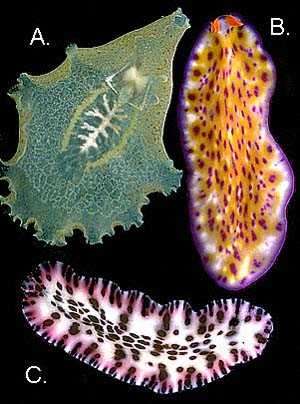
Flatworms
Phylum: PLATYHELMINTHES
PHOTO
Three common marine flatworms from south-eastern Australia.
A: Paraplanocera oligoglena.
B: Pseudoceros sp.
C: Eurylepta fuscopunctatus.
Photo: Bill Rudman.
Polyclad flatworms are free-living marine PLATYHELMINTHES, an animal phylum which also includes tapeworms, liver-flukes and other internal parasites. They are not related to sea slugs or other molluscs. Although very thin and delicate, flatworms are active carnivores and scavengers, using their proboscis to feed on dead or injured animals and colonial animals such as bryozoans and soft-corals. The worms can quickly glide along the bottom by using the fine hairlike cilia which cover their body. When disturbed they can swim for a considerable period of time by throwing the sides of their body into undulating waves.
For further information see:
-
Wolfgang Seifarth's website Marine Flatworms of the World
-
Dr. Marian Litvaitis' website at University of New Hampshire
-
Online Identification Key IDENT-A-WORM
-
L. Newman & L.Cannon: Marine Flatworms. The World of Polyclads
- L.Newman & L. Cannon: Fabulous Flatworms: a guide to marine polyclads
Rudman, W.B., 1998 (May 27) Flatworms. [In] Sea Slug Forum. Australian Museum, Sydney. Available from http://www.seaslugforum.net/find/flatworm
Related messages
Re: Yellow-spotted nudi from Red Sea
April 22, 2010
From: Déwald Swanepoel
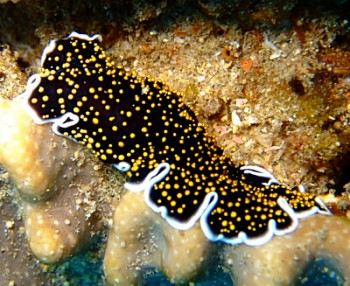
Concerning message #13191:
Hi Bill,
I'm just curious as to why you're saying that Henrik's animal is probably an unnamed species of Thysanozoon and not T. nigropapillosum?
I recently photographed a similar flatworm at Sodwana, South Africa which I identified as T. nigropapillosum but after having read this posting of yours I'm not so sure anymore.
Locality: Sodwana Bay, 15-20m, KwaZulu-Natal, Indian Ocean, 17 April 2010, Reef. Photographer: Déwald Swanepoel.
Regards,
Déwald Swanepoel
dewald.swanepoel@gmail.com
Swanepoel, d., 2010 (Apr 22) Re: Yellow-spotted nudi from Red Sea. [Message in] Sea Slug Forum. Australian Museum, Sydney. Available from http://www.seaslugforum.net/find/23553Dear Déwald,
In that earlier message I didn't actually say it was not T. nigropapillosum but I did say I was not an expert on flatworms and suggested anyone interested to refer to references on the Flatworm Fact Sheet. That was some years ago and experts I asked at the time identified it as Thysanozoon sp. It seems they now accept that it is T. nigropapillosum.
I have a few flatworms on the Forum because they are often mistaken for nudibranchs, but with few exceptions I deliberately don't identify them to species since I am not an expert. Like nudibranchs, flatworms are often difficult to identify, and expert opinion can change as more research is done. So my advice is to follow the most recent advice from an expert on flatworms, or a book or website authored by such an expert.
Best wishes,
Bill Rudman
Strange slug from Mallorca Island, Spain
February 17, 2010
From: Fernando Darder
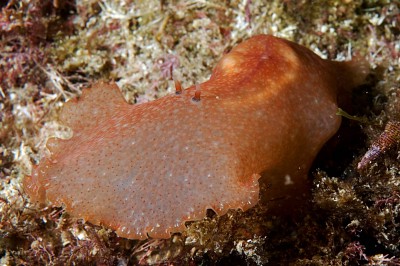
I found this slug a Night Dive at 21:50 inside a narrow and dark cave 10 meters from the exit
There is a similar flatworm, but this one had a shell in the bottom
I send a photo where you can see the shell.
Locality: Caló des Monjo, Paguera, Mallorca Island, 5 metres, Spain, Mallorca, Mediterranean, 06 June 2009, inside a narrow cave 10 meters from the exit. Length: 80 mm. Photographer: Fernando Darder.
Can you help me?
Best Regards
Fernando Darder
nando_darder@hotmail.com
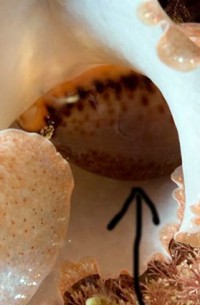
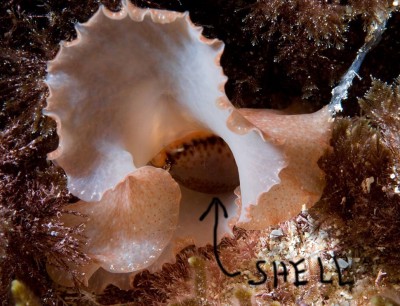
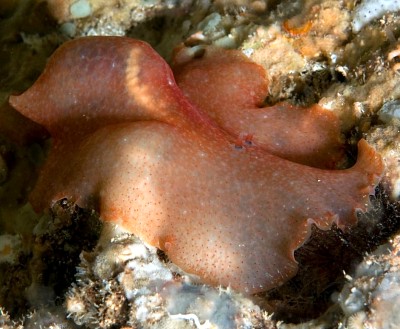
Dear Fernando,
This is indeed a flatworm, and the shell you can see - which looks like a cowry shell - is either being eaten by the flatworm or the flatworm is ejecting the shell after eating the animal. Flatworms are carnivorous and their 'mouth' is situated under the body. Have a look at the links I have on the Flatworm Fact Sheet.
Best wishes,
Bill Rudman
Re: Corambe sp. from Ratnagiri, India
November 23, 2009
From: John Chuk
Concerning message #22709:
Hi Bill,
I suspect this animal is a polyclad flatworm and not a Corambe sp. Small hoploplanid flatworms that feed on encrusting bryozoans do appear very similar to Corambe sp.
The image showing a portion of the ventral surface provides the evidence for the animal being a polyclad. The white patch partly seen in the centre of the ventral surface could well be the opaque folded pharynx of a hoploplanid.
If the animal was a Corambe sp. the foot and oral tentacles should be visible on the ventral image. I am unable to see either.
I'd be interested to know what you think?
Best wishes,
John.
jchuk@optusnet.com.au
Chuk, J, 2009 (Nov 23) Re: Corambe sp. from Ratnagiri, India. [Message in] Sea Slug Forum. Australian Museum, Sydney. Available from http://www.seaslugforum.net/find/22827Dear John,
I suppose I could think up some excuse to explain why my brain was misfiring when I answered Vishal's message. You are of course quite right - I can even remember wondering why I couldn't see the foot! I guess it's a few years since I was last fooled by a flatworm so I was about time for another one to keep me on my toes.
Best wishes,
Bill Rudman
Corambe sp. from Ratnagiri, India
November 6, 2009
From: Vishal Bhave
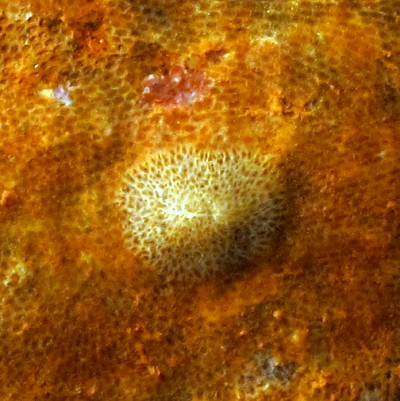
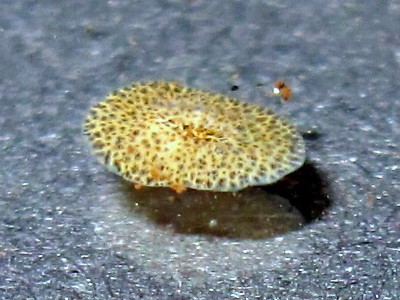
Hello,
In today's intertidal collection I got a species of Corambe. I want to identify it. What are important characters which we have to consider in such a highly cryptic and tiny species?
2 specimens were collected from Alawa, Ratnagiri.
On encrusting bryozoan like Membranipora sp. or alike (I am not sure about it's identity) on rock in an intertidal rockpool of ~10 cm depth.
Locality: Alawa, Ratnagiri, 10 centimeters, Maharashtra, India, Arabian sea, 17 October 2009, Rocky, Intertidal. Length: 4 mm. Photographer: Vishal Bhave.
Vishal Bhave.
vishalbhave@gmail.com
Bhave, V.J., 2009 (Nov 6) Corambe sp. from Ratnagiri, India. [Message in] Sea Slug Forum. Australian Museum, Sydney. Available from http://www.seaslugforum.net/find/22709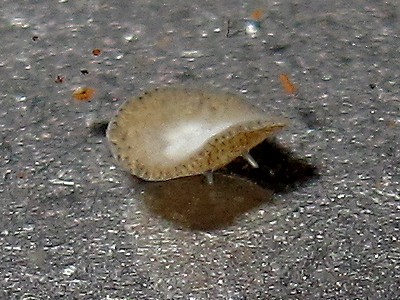
Note added 23 November 2009: This is a flatworm. See John Chuk's message #22827.
Dear Vishal,
It is always exciting to discover species of this highly specialised cryptic family. I am afraid photos alone a not enough to identify species, and although the number of gills and shape of the 'pallial notch' have been used, I suspect an anatomical investigation is often required. In message #9202 I have listed a few recent papers on the Family.
I am afraid at this stage species in the Indo-West Pacific have not been named, and because they can be distributed long distances on floating algae and logs, I suspect it will some time before we will know just how many species occur in the Indo-West Pacific
Best wishes,
Bill Rudman
Re: Acoel flatworms in aquaria
April 10, 2008
From: Thomas Shannon III
Concerning message #5836:
Hi Mike,
Granted, I'm writing this 5 years after your initial posting, but I figured that you might want to know that you were correct in stating that there are likely several other species of Convolutriloba... Four described species to date to be exact.
Not sure if you're still interested in these cute little guys, but after working with the Genus for about 10 years or so, and describing one of the species, I've finally got around to putting together a very simple dichotomous key for identifying members of the genus.
The ID webpage is at http://macropyga.googlepages.com/identification
Cheers,
Tom
macropyga@yahoo.com
Shannon, T., 2008 (Apr 10) Re: Acoel flatworms in aquaria. [Message in] Sea Slug Forum. Australian Museum, Sydney. Available from http://www.seaslugforum.net/find/21513Thanks Tom,
It's never too late to answer or comment on a Forum message. Although I try and avoid non 'sea slug' matters simply because I have no time I have a great interest in all of these solar-powered animals. I don't know why I hadn't made the connection between Convolutriloba and the little animal I called Convoluta in an earlier message [#627]. In your thesis [see link on Tom's home page] I was fascinated by your report on how the behaviour of your flatworms seemed to be connected to the welfare of the symbiotic algae in their bodies. This is exactly what I noticed with a little green acoel which I identified as Convoluta many years ago in East Africa. In the earlier message I mention above I describe how the worms would adjust their position apparently to maintain an optimum light level in the bright tropical sun. Perhaps using this aversion to bright light could be used in some way to help get rid of infestations from home aquariums?
Best wishes,
Bill Rudman
The flatworm Vorticeros from New Zealand
November 23, 2007
From: Dennis Gordon
Concerning message #17305:
Hi Bill
When searching for information on acoel flatworms on the internet, I chanced upon the pages on Sea Slug Forum dealing with flatworms mistaken as opisthobranchs. Angela Dinapoli's "Unknown Opisthobranch from New Zealand" [message #17305] represents an undescribed species of the prolecithophoran flatworm Vorticeros. This species was illustrated by Gordon (1972) in a drawing depicting biological associates of under-boulder bryozoan assemblages at Goat Island Bay, Cape Rodney to Okakari Point Marine Reserve, Leigh, New Zealand. The specimen encountered by me was only 0.7 mm long, whereas Dinapoli's specimens attained 3 millimetres.
The Platyhelminthes have undergone significant changes in classification in recent decades, owing to improved understanding of phylogenetic relationships within the phylum. Accordingly, the former class Turbellaria is no longer recognized as such. Vorticeros is classified as follows: Subphylum Rhabditophora, Class Neoophora, Subclass Prolecithophora, Order Separata, family Plagiostomidae. Vorticeros is recognized by its distinctive tentacle-like anterior appendages.
Species of Vorticeros are often associated with bryozoans, but there is no evidence as yet that the undescribed species at Goat Island Bay is a bryozoan predator.
-
Dinapoli, A. 2006 (Aug 3) Unknown Opisthobranch from New Zealand by Angela Dinapoli. [Message in] Sea Slug Forum. Australian Museum, Sydney. Available from http://www.seaslugforum.net/find/17305
-
Gordon, D.P. 1972. Biological relationships of an intertidal bryozoan population. Journal of Natural History 6: 503-514.
Cheers,
Dennis
Dr Dennis P. Gordon FLS
Principal Scientist, Aquatic Biodiversity & Biosecurity
National Institute of Water & Atmospheric Research
Wellington, New Zealand
d.gordon@niwa.co.nz
Gordon, D.P., 2007 (Nov 23) The flatworm Vorticeros from New Zealand. [Message in] Sea Slug Forum. Australian Museum, Sydney. Available from http://www.seaslugforum.net/find/21182Thanks Dennis,
Bill Rudman
Unknown nudibranch from Indonesia
September 19, 2007
From: Eugene Yeo
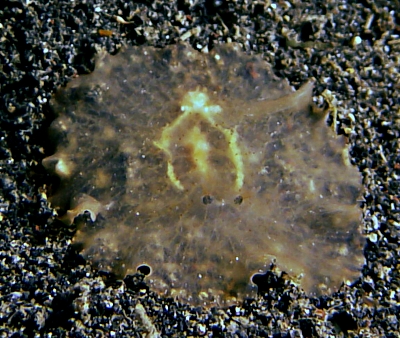
Hi Bill,
I captured this image of nudibranch in Lembeh Striat and i'm unable to identify it. Seems like this species only comes out during night dive. Could you please identify it for me?
Locality: Lembeh Strait, Indonesia, Indo Pacific, 12-16 July, 2007, Muck. Photographer: Eugene Yeo.
Thanks.
Eugene Yeo
eyeo@mail.une.edu
Yeo, E., 2007 (Sep 19) Unknown nudibranch from Indonesia. [Message in] Sea Slug Forum. Australian Museum, Sydney. Available from http://www.seaslugforum.net/find/20734Dear Eugene,
This is a flatworm. See the Fact Sheet for more information.
Best wishes,
Bill Rudman
Re: Flatworm from Bohol, Philippines
August 16, 2007
From: Marian Litvaitis
Concerning message #19622:
Hi Jim,
It definitely is a polyclad flatworm and it has been recorded in the Philippines before. It belongs to the genus Pseudoceros.
See: http://www.rzuser.uni-heidelberg.de/~bu6/flat0407.html
and also:
http://www.rzuser.uni-heidelberg.de/~bu6/flat0230.html
Cheers,
The Flatworm Wranglers
m.litvaitis@unh.edu
Litvaitis, M., 2007 (Aug 16) Re: Flatworm from Bohol, Philippines. [Message in] Sea Slug Forum. Australian Museum, Sydney. Available from http://www.seaslugforum.net/find/20334Thanks Marian,
Bill Rudman
Nudibranch? from Bali region, Indonesia
August 16, 2007
From: Robert Borzymek
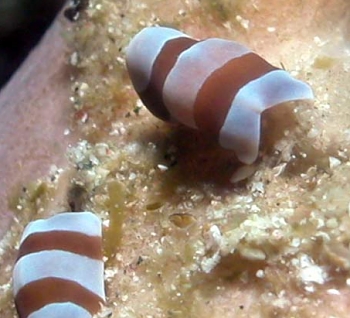
Dear Bill,
Please help us with identification of attached nudibranch. I have made a photo on about 15 m depth, the species were very small - around 0,4 cm. The photo was taken by Moyo Island in Indonesia between Komodo and Lombok Island.
Locality: Moyo Island, 15 m, Indonesia, Bali Sea, 04 April 2006. Length: 4 mm. Photographer: Robert Borzymek.
Best regards
Robert Borzymek
http://www.underwater.pl
r.borzymek@underwater.pl
Borzymek, R., 2007 (Aug 16) Nudibranch? from Bali region, Indonesia. [Message in] Sea Slug Forum. Australian Museum, Sydney. Available from http://www.seaslugforum.net/find/20178Dear Robert,
Have a look at the Flatworm Fact Sheet. We have quite a few messages [see #14890] with this species of acoel flatworm. Try some of the links on the Fact Sheet for more information
Best wishes,
Bill Rudman
Re: This is probably not a sea slug
July 10, 2007
From: Ken Tucker
Concerning message #19412:
I've received the following info:
--------------------------------------
"Your flatworm is an acoel, family Convolutidae, possibly in the genus Amphiscolops. I haven't been able to get any information on it so this id my uninformed guess based on the size and body shape. I've seen several photographs of this species before. All were taken from Indonesia with the possible exception of one which didn't have a locality attached. It's unusually large for an acoel which tend to be micrograzers and predators. Sorry I can't give you any more info."
Cheers,
Leslie H. Harris
Collection Manager,
LACM-Allan Hancock Foundation Polychaete Collection
Natural History Museum of Los Angeles County
---------------------------------------
Ken Tucker
ken@kilili.com
Tucker, K.C., 2007 (Jul 10) Re: This is probably not a sea slug. [Message in] Sea Slug Forum. Australian Museum, Sydney. Available from http://www.seaslugforum.net/find/20175Thanks Ken,
Yes there are several examples amongst the flatworm messages in the Forum. I am sorry I can't deal more fully with flatworms I have neither the expertise or the time.
Best wishes,
Bill Rudman
Flatworm from Bohol, Philippines
July 10, 2007
From: James Spears
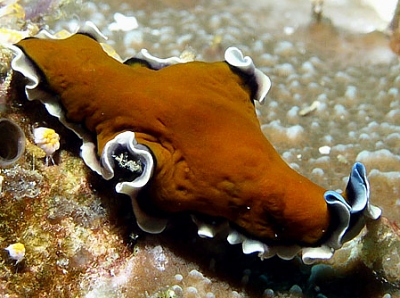
I have not been able to identify this sea slug from any of the books that I have.
Locality: Puntod Reef, Panglao Island, 50 feet, Bohol, Philippines, Philippine Sea, 28 February 2007, wall dive. Length: 1.5 inches. Photographer: Jim Spears.
Can someone ID it for me.
Thank you.
James Spears
islandjim@gmail.com
Spears, J., 2007 (Jul 10) Flatworm from Bohol, Philippines. [Message in] Sea Slug Forum. Australian Museum, Sydney. Available from http://www.seaslugforum.net/find/19622Dear Jim,
This is a flatworm. Unfortunately, as I say elsewhere on the Forum today, I don't have the time or the expertise to identify these animals, but you will find some useful links on the Fact Sheet.
Your photo shows very clearly how in some flatworms there are a pair of head tentacles which are developed from semipermanent or permanent folds of the edge of the body. In species with such 'false tentacles' it is easy to be fooled into thinking they are the rhinophores of a nudibranch.
Best wishes,
Bill Rudman
Flatworm from Palau
July 4, 2007
From: Peter Denton
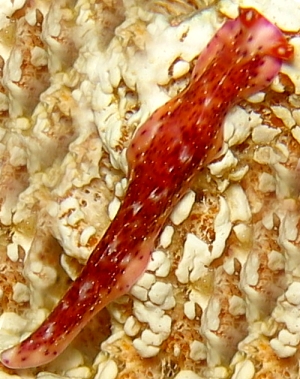
I found this sea slug in Palau at about 30 feet on the reef wall, it was last May, he was very small. I really don't think its a flat worm because it has proper rhinophores. Please help me ID this creature, I was working on the Aggressor at the time and none of the other staff had ever seen one before which is quite a statement considering how much experience those guys had in that area!
Locality: Island, 30 feet, Palau, pacific ocean, 10 May 2006, reef wall. Length: one inch. Photographer: Peter Denton.
Peter Denton
fontainedenton@yahoo.com
Denton, P., 2007 (Jul 4) Flatworm from Palau. [Message in] Sea Slug Forum. Australian Museum, Sydney. Available from http://www.seaslugforum.net/find/19633Dear Peter,
I am afraid some flatworms have very rhinophore-looking head tentacles. Check some of the links I indicate on the Fact Sheet
Best wishes,
Bill Rudman
This is probably not a sea slug
June 19, 2007
From: Ken Tucker
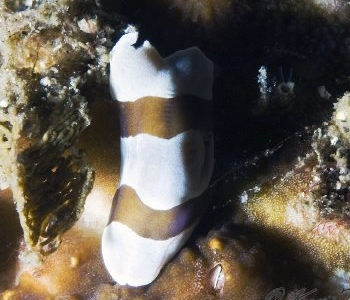
I've not the slightest idea what this might be. Perhaps someone can hazard a guess?
Locality: Lembeh Strait - Tansu Rusa, 8 metres, Indonesia, Sulawesi, 30 Nov 2006. Length: 6 cm. Photographer: Ken Tucker.
Ken Tucker
ken@kilili.com
Dear Ken,
This is a type of flatworm [see earlier message #14890].
Best wishes,
Bill Rudman
Leopard - coloured animal
May 28, 2007
From: Joy Go
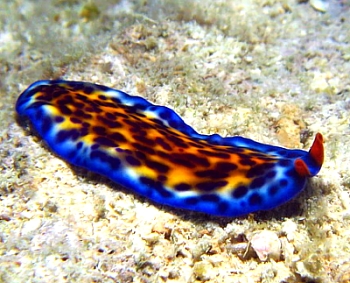
Dear Bill,
Here's another one I can't seem to find a match for in my references.
Locality: Baul Island, Salcedo, 5 meters, Philippines, Leyte Gulf, 21 November 2006, Reef Wall. Length: 2 inches. Photographer: Joy D. Go.
Thanks & regards,
Joy D. Go
joygo8@gmail.com
Go, J.D., 2007 (May 28) Leopard - coloured animal. [Message in] Sea Slug Forum. Australian Museum, Sydney. Available from http://www.seaslugforum.net/find/18906Dear Joy,
This is a flatworm. If you go to the Fact Sheet you will find more information on these fascinating animals. As much as I would like to, I haven't the time or knowledge to adequately answer questions on their identity.
Best wishes,
Bill Rudman
Re: Unknown Sea Slug? from Antibes, France
March 28, 2007
From: Marian Litvaitis
Concerning message #19653:
Hi Dominique,
Great shots of a beautiful flatworm! We've been discussing it in my lab and the general consensus is that it may be a stylochid polyclad. Without histlogical sectioning, it will be impossible to make a positive identification, though.
Generally, stylochids are quite dull in coloration, mostly brown, gray or translucent. It usually is the tropical cotyleans that are so brightly colored. So your specimen is very much unique, and most likely a new species.
Hope this helps.
The Flatworm Wranglers
Marian Litvaitis
Sigmer Quiroga
Marcela Bolanos
Dept of Zoology
University of New Hampshire
Durham, NH 03824 USA
m.litvaitis@unh.edu
Litvaitis, MK, 2007 (Mar 28) Re: Unknown Sea Slug? from Antibes, France. [Message in] Sea Slug Forum. Australian Museum, Sydney. Available from http://www.seaslugforum.net/find/19759Thanks Marian,
Bill Rudman
Re: Caribbean sea slug?
March 24, 2007
From: Marian Litvaitis
Concerning message #19654:
Hi Wendy,
It's Pseudobiceros pardalis, or Pseudoceros pardalis. It depends on the number of male pores (seen only on the underside). We have found this species in Panama, too. It originally was described from Bermuda as Pseudoceros pardalis but we're in the process of correcting the original description because of the two male pores.
Regards,
Marian Litvaitis
Dept of Zoology
Univ of New Hampshire
Durham, NH 03824 USA
m.litvaitis@unh.edu
Litvaitis, MK, 2007 (Mar 24) Re: Caribbean sea slug?. [Message in] Sea Slug Forum. Australian Museum, Sydney. Available from http://www.seaslugforum.net/find/19750Thanks Marian,
Bill Rudman
Re: Caribbean sea slug?
March 22, 2007
From: Wendy Kornberg
Concerning message #19654:
Yay! I'm pretty sure this animal is a Pseudoceros pardalis Verrill. Thanks for the links.
Wendy Kornberg
Lucifinamae@hotmail.com
Kornberg, W., 2007 (Mar 22) Re: Caribbean sea slug?. [Message in] Sea Slug Forum. Australian Museum, Sydney. Available from http://www.seaslugforum.net/find/19736Unknown Sea Slug? from Antibes, France
March 22, 2007
From: Dominique Horst
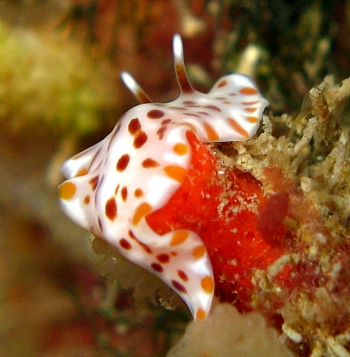
I had a long hesitation to post this message on the Forum. My initial thought was a flatworm and I didn't want to add an unuseful message. My friend P. Francour, suggested that it should be a sea slug. So I would appreciated your help to identify this Mediterranean flat sea slug...
Locality: Cap d'Antibes, 20m, France, Mediterranean sea, 10 March 2007, rocks. Length: 15mm. Photographer: Dominique Horst.
Many thanks in advance
Kind regards,
Dominique
dominique.horst@wanadoo.fr
Horst, D., 2007 (Mar 22) Unknown Sea Slug? from Antibes, France. [Message in] Sea Slug Forum. Australian Museum, Sydney. Available from http://www.seaslugforum.net/find/19653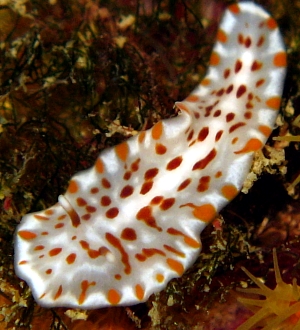
Dear Dominique,
I find it hard to resist a photo of a colourful animal. However, as you suspected, this is a flatworm, despite its realistic 'rhinophores '.
Best wishes,
Bill Rudman
Caribbean sea slug?
March 15, 2007
From: Wendy Kornberg
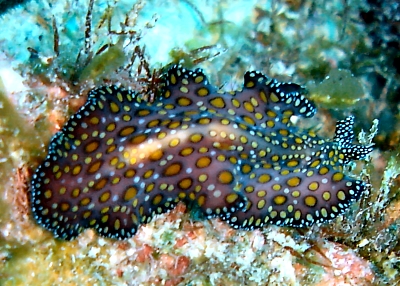
I love your site, but seeing how I don't know what class, family, or species this animal is, I can't navigate your species list very well. I was hoping you could tell me what kind of slug this is. I found it in the Caribbean, off the coast of Grenada, in aprox. 30 feet of water. It was about 3 to 4 cm long.
Locality: Grenada, 30 feet, Caribbean, Atlantic Ocean, 16 December 2006, Healthy Coral Reef. Length: 3 to 4 cm. Photographer: Wendy Kornberg.
Thanks!
Wendy Kornberg
Lucifinamae@hotmail.com
Kornberg, Wendy M., 2007 (Mar 15) Caribbean sea slug?. [Message in] Sea Slug Forum. Australian Museum, Sydney. Available from http://www.seaslugforum.net/find/19654Dear Wendy,
I nnte that you have given your photo the filename 'Caribbean Flat Worm' - which is exactly what it is. As much as I would like to, I have neither the time nor the expertise to expand in that direction. Have a look at the flatworm Fact Sheet on where to find more information on these animals
Best wishes,
Bill Rudman
Discodoris ? from Fremantle, Western Australia
February 23, 2007
From: Brent Murdoch
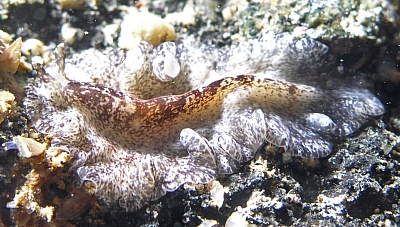
Hi,
On a night dive yesterday I found what looks to be some type of Discodoris.
As far as I can tell it has not been recorded in WA.
Locality: Swan River, Fremantle, 4m, Western Australia, Indian, 18 February 2007, sand / limestone. Length: 60mm. Photographer: Brent Murdoch.
Brent Murdoch
brent@murdoch.id.au
Murdoch, B.D., 2007 (Feb 23) Discodoris ? from Fremantle, Western Australia. [Message in] Sea Slug Forum. Australian Museum, Sydney. Available from http://www.seaslugforum.net/find/19496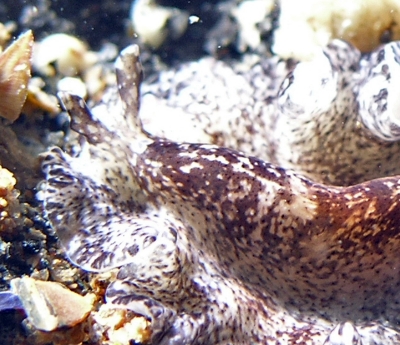
Dear Brent,
This is a flatworm not a nudibranch. If you go to the flatworm Fact Sheet you will see some links to identification aids. At some stage, we all get tricked by these animals. Many have rhinophore-looking head tentacles as in your close-up alongside. Two fairly good ways to separate them from nudibranchs is that their body is a simple thin sheet of tissue - no separation into mantle, body and foot, and they glide along very quickly - certainly not at a snail or slug's pace.
Best wishes,
Bill Rudman
Re: Flatworm identifications
January 4, 2007
From: Anne DuPont
Re: message #18628
Hello Mike,
I saw your December 30th post on the Sea Slug Forum, and your request for a website that helps with identifying flatworms. Here are two guides that will be very helpful to you:
There is a group from the University of New Hampshire who work on Polyclad Flatworms and the team is headed up by Dr. Marian Litvaitis. She has worked with Flatworms for over 20 years.
http://zoology.unh.edu/faculty/litvaitis/Wranglers/personnel.htm
and click on "Research"
Access the identification key: IDENT-A-WORM
http://pick4.pick.uga.edu/mp/20q?guide=Rhabditophora&flags=not_no:
Also:
Marine Flatworms of the World
http://www.rzuser.uni-heidelberg.de/~bu6/index.html
Cordially,
Anne DuPont
akdupont@bellsouth.net
DuPont, A., 2007 (Jan 4) Re: Flatworm identifications. [Message in] Sea Slug Forum. Australian Museum, Sydney. Available from http://www.seaslugforum.net/find/19104Dear Anne,
Thanks for this additional information. I had Wolfgang Seifarth's great site on the Flatworm Fact Sheet but not Dr. Marian Litvaitis'. I have also added links to the Newman & Cannon book and CD. I see Leslie Newman was involved in the IDENT-A-WORM key, which I guess explains its similarity to the key on the Newman & Cannon CD.
All are valuable aids to identifying marine flatworms.
Best wishes,
Bill Rudman
Re: Flatworm identifications
January 4, 2007
From: Leanne & David Atkinson
Concerning message #18628:
Re: Flatworm Resources,
We recently purchased "Fabulous Flatworms a guide to marine polyclads " by Leslie Newman and Lester Cannon from the Australian Museum's Bookshop. It is a CD rom with over 1200 magnificant colour photographs and it covers 400 species. We had very limited knowledge of flatworms prior to using this CD rom. It has been easy to use and very helpful for us to identify the flatworms we have been finding lately. It was published by CSIRO. We also have their book with a similar name for when a computer is not available.
The Sea Slug Forum pages have a tab at the top to navigate your way into the general museum website including the bookshop.
Hope this helps,
Leanne & David Atkinson
atk@hunterlink.net.au
Atkinson, L. & D., 2007 (Jan 4) Re: Flatworm identifications. [Message in] Sea Slug Forum. Australian Museum, Sydney. Available from http://www.seaslugforum.net/find/19110Dear Leanne & David,
I posted a review of that CD over a year ago but for some reason - perhaps when the site crashed - it has disappeared. Thanks to your message I discovered its absence and have reposted it: Fabulous Flatworms: A guide to marine polyclads. There is a link there to the book.
Best wishes,
Bill Rudman
Re: Flatworm from the Red Sea
October 30, 2006
From: Fabio Russo
Concerning message #17576:
Dear Bill,
the flatworm you can see in this message is Thysanozoon nigropapillosum, you can read something on this worm at: http://www.edge-of-reef.com/platelminti/PLAThysanozoonnigropapillosumen.htm
Best wishes!
Fabio Russo
scercola@alice.it
Russo, F., 2006 (Oct 30) Re: Flatworm from the Red Sea. [Message in] Sea Slug Forum. Australian Museum, Sydney. Available from http://www.seaslugforum.net/find/17833Thanks Fabio,
Bill Rudman
Flatworm from the Red Sea
September 9, 2006
From: Luigi Crisanti
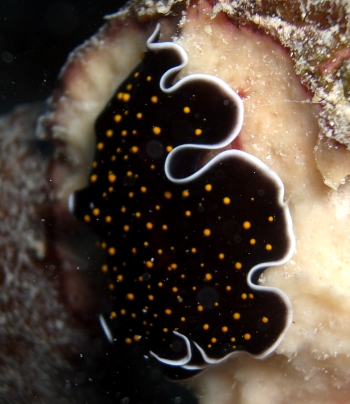
I have search the name of this nudibranch on the book "Red Sea" by Helmut Debelius but I have not found it.
Locality: Saint John Reef, 15 mt, Egypt, Red Sea, 16 August 2006, reef. Length: 2-3 cm. Photographer: Luigi Crisanti.
Do you know this species?
Thank You
Luigi Crisanti
luigicrisanti@libero.it
Crisanti, L., 2006 (Sep 9) Flatworm from the Red Sea. [Message in] Sea Slug Forum. Australian Museum, Sydney. Available from http://www.seaslugforum.net/find/17576Dear Luigi,
This is a flatworm
Best wishes,
Bill Rudman
Unknown Opisthobranch from New Zealand
August 3, 2006
From: Angela Dinapoli
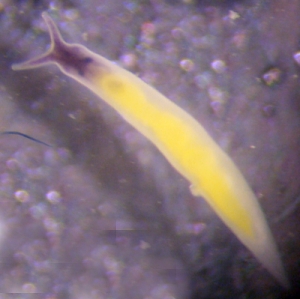
Dear Bill,
I found those two specimens during a collecting trip in New Zealand and I have no idea where they belong to. Could you please help me with the identification.
Locality: Upper photo: Leigh, 1 m, North Island, New Zealand, South Pacific Ocean, 30 April 2006, Intertidal, on algae. Length: 2 mm. Lower photo: Pahia, North Island, New Zealand Depth: 1 m. Length: 3 mm. 22 May 2006. Intertidal, on algae. Photographer: Angela Dinapoli.
Best regards
Angela
a.dinapoli@bio.uni-frankfurt.de
Dinapoli, A., 2006 (Aug 3) Unknown Opisthobranch from New Zealand. [Message in] Sea Slug Forum. Australian Museum, Sydney. Available from http://www.seaslugforum.net/find/17305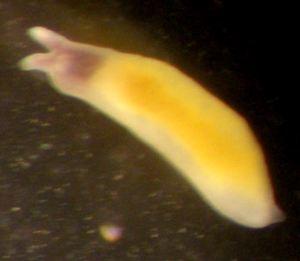
Note added 23 November 2007: This is a species of Vorticeros - see message #21182.
Dear Angela,
Despite the slug-like look, I am pretty sure this is one of a group of tiny flatworms. The only way to be sure would be to check its anatomy, but from the photos there does not seem to be a distinction between the foot and the body. Also the area around Leigh, where the University of Auckland marine laboratory is situated has been a collecting haunt of a number of opisthobranch workers for many years, including Michael Miller and Richard Willan, and I am pretty sure an animal like yours, despite its small size, would not have escaped their eagle eyes, and attention, if it were an opisthobranch.
Best wishes,
Bill Rudman
Flatworm from the Red Sea
August 3, 2006
From: Ken McQuilton
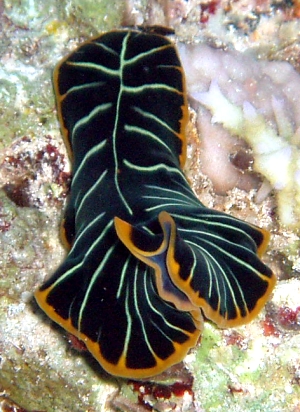
Hi,
I took this picture in Jan 2006 whilst on a liveaboard in the Northern Red Sea. I've had a scout around but have not found anything similar so thought I would ask the experts.
Locality: Shaab Mahmoud Reef, 15-20 metres, Eygpt, Red Sea, 14 Jan 2006, Reef. Length: 1 - 2 inches. Photographer: Ken McQuilton.
I look forward to being enlightened.
Best Regards
Ken McQuilton
ken.mcquilton@cw.com
McQuilton, K.K., 2006 (Aug 3) Flatworm from the Red Sea. [Message in] Sea Slug Forum. Australian Museum, Sydney. Available from http://www.seaslugforum.net/find/17306Dear Ken,
I'm afraid you will have to look elsewhere for 'enlightenment', but I can say this is not a sea slug. It is a polyclad flatworm, probably of the genus Pseudoceros. The 'ears' you can see at the front are just folds - if fairly permanent - of the front edge of the body and are called pseudotentacles.
Best wishes,
Bill Rudman
Is this a Hydatina species?
July 12, 2006
From: Asther M. Lau
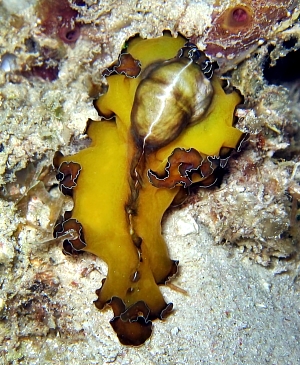
Concerning message #12170:
Hello Bill,
Can you help in ID this slug? Can't seem to find an accurate info from the web.
Locality: Dayang Island, 10 meters, Johor, Malaysia, South China Sea, 22 February 2004, Sandy bottom. Length: About 10cm. Photographer: Francis Tan.
Thank you so much!
Asther
asther@astherlau.com
Lau, A, 2006 (Jul 12) Is this a Hydatina species?. [Message in] Sea Slug Forum. Australian Museum, Sydney. Available from http://www.seaslugforum.net/find/17109Dear Asther,
The swollen lump at the front of the body does make it look a bit like a species of shelled cephalaspidean, like Hydatina, but it is a flatworm. The swollen lump is probably something it has recently ingested and is gradually digesting.
Best wishes,
Bill Rudman
Possible Discodoris boholiensis from the Philippines
March 6, 2006
From: Kerry Hulme
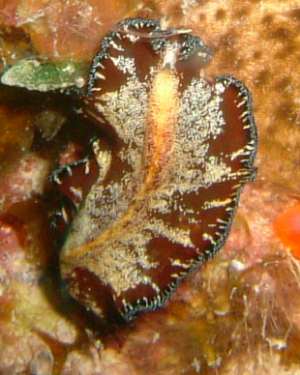
Hello!
I'm currently writing up my research work from a series of reef surveys I did in the Philippines and Indonesia last summer and would like a positive ID on this species if possible! Its a little different to other Discodoris boholiensis i've seen before so would like an expert opinion if you dont mind.
The above species was seen swimming and then settled on a rock surface
Locality: Marcilla, Coron, Palawan, 5-7metres, Philippines, south china sea, 23 April 2005. Length: 2.5cm. Photographer: Kerry Hulme.
Kerry Hulme
HA211650@ntu.ac.uk
Hulme, K.E., 2006 (Mar 6) Possible Discodoris boholiensis from the Philippines. [Message in] Sea Slug Forum. Australian Museum, Sydney. Available from http://www.seaslugforum.net/find/16030Dear Kerry,
The fact that it was swimming and the lack of gills and rhinophores suggest this is not a dorid nudibranch. I am pretty sure it is a polyclad flatworm, most probably Tytthosoceros lizardensis.
Best wishes,
Bill Rudman
Aglajid ? from the Banda Sea
February 8, 2006
From: Nick Hobgood
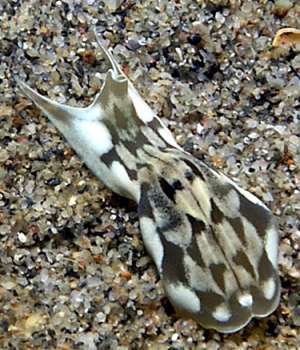
Dear Bill,
We ran in to three individuals of this species where two larger ones were quickly moving towards each other while a much small third was motionless nearby. When the two met they quickly formed a ball and then parted and went in opposite directions (second photo). This all happenend in a matter of seconds. I cannot find these in any of my field guides, can you help ID them ?
Locality: East Timor, Banda Sea. Depth: 5 meters. Length: 1 cm. 05 February 2006. sandy bottom. Photographer: Nick Hobgood
Thanks
Nick
nick.hobgood@mac.com
Hobgood, N, 2006 (Feb 8) Aglajid ? from the Banda Sea. [Message in] Sea Slug Forum. Australian Museum, Sydney. Available from http://www.seaslugforum.net/find/15761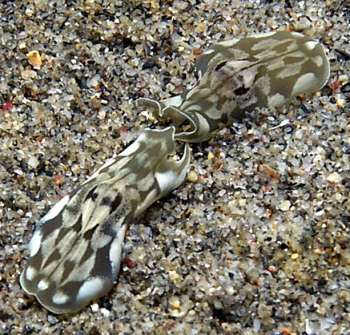
Dear Nick,
These are acoel flatworms. Not as colourful as the usually large polyclad flatworms, but the acoels often occur in very large numbers. I don't know if it is just coincidence that they have a forked tail, which looks very similar to that of Chelidonura, a genus of opisthobranchs which feed on them.
Your animal is probably the same species as the one in Atsushi Ono's message [#974]. Like most flatworms they move much faster than most sea slugs.
Best wishes,
Bill Rudman
Flatworm on ray
December 19, 2005
From: Frank Hoefken
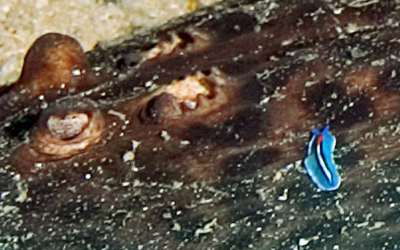
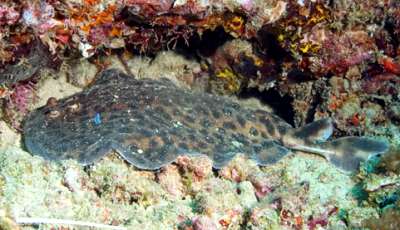
Last month I went to Kenya for diving. During one dive, I took a picture of what I believe is a blackspotted torpedo ray. It was only when I looked at the pictures on my notebook at home that I realized there was a nudibranch on top of the torpedo ray. I have tried to find out what nudibranch it is, but as I am no expert in this field, I did not find it neither in one of my books, nor in the internet. But searching the www, I happened to find your site, and maybe you can help me. Unfortunately, I do not have a larger picture, because I used a wide angle lens.
Locality: near Mombasa, Kenya, Indian Ocean. Depth: about 12 metres. Length: about 20 mm.18 November 2005. coral reef, on top of a torpedo ray. Photographer: Frank Hoefken
Greetings from Germany,
Frank
Frank@Hoefken.name
Hoefken, F., 2005 (Dec 19) Flatworm on ray. [Message in] Sea Slug Forum. Australian Museum, Sydney. Available from http://www.seaslugforum.net/find/15501Dear Frank,
This is a flatworm, not a nudibranch, but certainly on first appearances it is easy to mistake them. I think it is a species of Pseudoceros, and possibly an unnamed species.
Best wishes,
Bill Rudman
Another flatworm from Indonesia
December 19, 2005
From: Ken Tucker
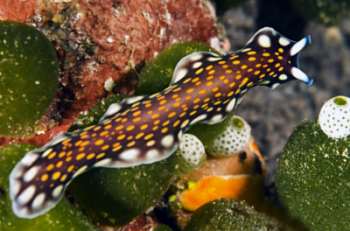
Descriptor info is below. I have not been able to match to either SS database or any other reference material. I have numerous photos. Can you suggest.
Locality: Indonesia, Tucanbesi Islands, Wakatobi. Depth: perhaps 30 ft. 29 Oct 05. Photographer: Ken Tucker
Ken Tucker
ken@kilili.com
Tucker, K.C, 2005 (Dec 19) Another flatworm from Indonesia. [Message in] Sea Slug Forum. Australian Museum, Sydney. Available from http://www.seaslugforum.net/find/15486Dear Ken,
This is a flatworm. I do not want to become a de facto Flatworm site, but it is useful to have some flatworms illustrated on the Forum as they are often diffixult to distinguish from nudibranchs, especially when they have head 'tentacles' as in this species, which is Pseudoceros lindae.
Best wishes,
Bill Rudman
Swarming - of a different kind - in St. Vincent
November 14, 2005
From: Les Wilk
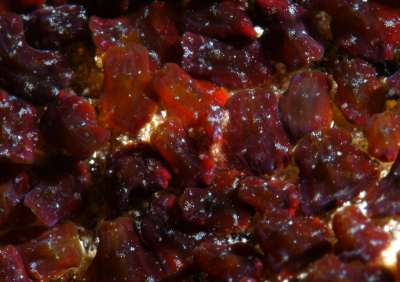
Hi Bill
From a distance it looked like a blanket of maroon-coloured algae covering the sides of the boulders and coral heads. Up close, though, it was a seething mass of tiny (3-4 mm) creatures. Thousands of them. Our first thought was juvenile slugs. Comments?
Locality: West side St. Vincent Is. Caribbean. Depth: 30 feet. Length: 3-4 mm. 28 June 2005. reef. Photographer: Keri Wilk
Les Wilk
wilk@reefnet.ca
Wilk, L., 2005 (Nov 14) Swarming - of a different kind - in St. Vincent. [Message in] Sea Slug Forum. Australian Museum, Sydney. Available from http://www.seaslugforum.net/find/15258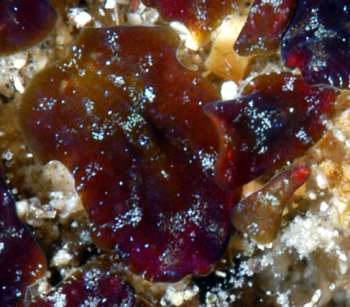
Dear Les,
These are Acoel flatworms. They are usually considered relatives of the colourful Polyclad flatworms, which are often mistaken for nudibranchs, but recent research suggest they may be a distinct Phylum of their own. Unlike the Polycladida, which have a 'many branched' gut [poly = many; cladida = branches], the Acoela have no gut [A= no; coel = gut cavity]. It is usually assumed that the gut has been lost in acoels because they have symbiotic unicellar organisms [often zooxanthellae] to provide nutrition, but researchers are now beginning to wonder whether they have always been 'gutless'.
As far as their relationship to the Sea Slug Forum, I guess I have said enough. However they are often found swarming on corals and sponges, and are probably the food of aglajids, such as Chelidonura.
Best wishes,
Bill Rudman
Flatworm from East Timor
October 17, 2005
From: Brian Francisco
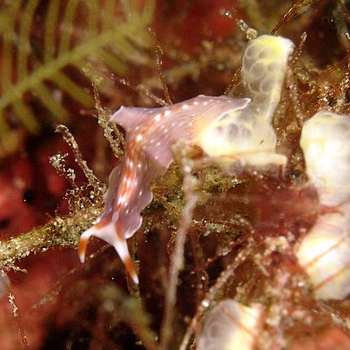
Bill
We see a variety of nudis and flatworms here in East Timor, but this one is a bit unusual as it has the body shape of a flatworm along with "true" rhinophores of a nudi.
Locality: Depth: East Timor. 10 m, Length: 2.5 cm. 18 September 2005. intertidal reef. Photographer: Brian Francisco
Could you help us identify it?
Thanks very much.
Brian
francisco.brian@gmail.com
Francisco, J.B., 2005 (Oct 17) Flatworm from East Timor. [Message in] Sea Slug Forum. Australian Museum, Sydney. Available from http://www.seaslugforum.net/find/15025Dear Brian,
Its head tentacles certainly look like a nudibranch's rhinophores but it is a flatworm, probably of the Family Euryleptidae, which have permanent tentacles like this.
Best wishes,
Bill Rudman
Re: Is this a nudibranch??
October 11, 2005
From: Roberto Sozzani
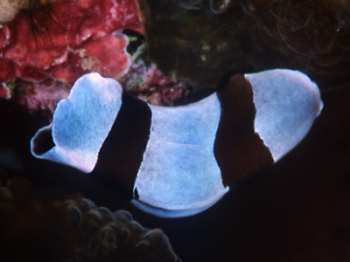
Dear Bill,
Concerning message #14890:
I have a similar photo which was puzzling me since a long time. There were many of them, on a large coral block. Not far, at about 50cm., three Chelidonura amoena.
Locality: Rinja Island, Indonesia. Depth: 12 meters. Length: 5-7 mm. June 2003. Coral reef. Photographer: Roberto Sozzani
Once again you helped to resolve one of my many 'mysteries'!
Thanks!
Roberto Sozzani
roberto.sozzani@fastwebnet.it
Sozzani, R., 2005 (Oct 11) Re: Is this a nudibranch??. [Message in] Sea Slug Forum. Australian Museum, Sydney. Available from http://www.seaslugforum.net/find/14978Dear Roberto,
Glad to be of help - but the beauty of the Forum is that it is definitely a two-way street. By your contributions of photos and observations we are building up an enormous resource of new information on these fascinating animals.
Best wishes,
Bill Rudman
Is this a nudibranch??
October 10, 2005
From: Elissa Mayo
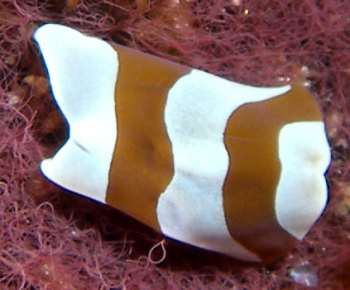
Hello,
I've exhaused the species' guides at hand in identifying this animal (a second animal is located in the upper left corner of the full picture [below])
I photographed it at a depth of about 80 feet on 9-22-05 at Wakatobi in the Tomia island group, Indonesia. Though I didn't have a measuring device handy, it was about the size of a small pencil lead. This shot was taken with a macro lens attachment, its color appears to be brown or purple and white bands.
Locality: boat dive off Tomia Island, Wakatobi Island Group, Indonesia
Banda Sea. Depth: 80 feet. Length: less than 1 cm. 25 September 2005. on reef slope wall. Photographer: Elissa Mayo.Thompson
Can you tell me if it is a nudibranch or similar or aeolid or other??
Thanks for your help!
Elissa Mayo
elissa.mayo@doj.ca.gov
Mayo, E., 2005 (Oct 10) Is this a nudibranch?? . [Message in] Sea Slug Forum. Australian Museum, Sydney. Available from http://www.seaslugforum.net/find/14890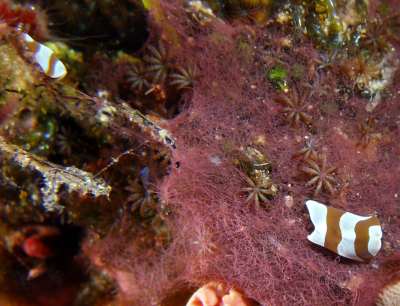
Dear Elissa,
Although it looks a bit like a species of Chelidonura, your animal is a flatworm. These small flatworms belong to a group which often occur in huge numbers on sponges and softcorals, and infest aquaria. They are also the most likely food of Chelidonura species.
Best wishes,
Bill Rudman
What slug is this?
August 13, 2005
From: Arne Stremlau
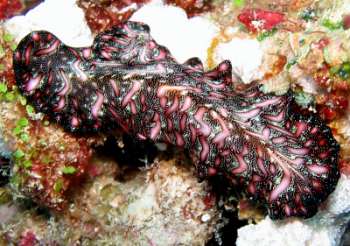
Hello!
I took a picture of a fast moving slug during a dive in the south Ari Atoll, Maldives.
Locality: Kuda Rah Thila, Rep. of Maldives, Indian Ocean. Depth: 21 metres. Length: 70-80 mm. 6 July 2005. Photographer: Arne Stremlau
I have no idea what slug it is and was hoping to get some help on id'ing it
thanks
Arne
arnes@microsoft.com
Stremlau, A, 2005 (Aug 13) What slug is this? . [Message in] Sea Slug Forum. Australian Museum, Sydney. Available from http://www.seaslugforum.net/find/14482Dear Arne,
This is a flatworm, not a nudibranch. Its name is Pseudobiceros bedfordi. It is sometimes hard to tell nudibranch and flatworms apart without having a close look. One good field indication though is how quickly they crawl. Your description of it as a fast moving slug is a pretty good indication that it is a flatworm. As much as I like them, nudibranchs are very slow.
Best wishes,
Bill Rudman
Aglajidae? or flatworm?
July 4, 2005
From: Roberto Sozzani
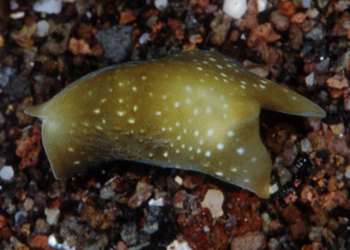
Dear Bill,
This is one of the (still too) many species which I can't identify. I made a search in the forum for 'aglajidae' but I didn't find anything with these colours.
Locality: Alor Island, Indonesia. Depth: 12 metres. Length: 8-10 mm. June 2003. Wall with black sand. Photographer: Roberto Sozzani
I hope you can help me!
Best wishes,
Roberto Sozzani
www.robertosozzani.it
roberto.sozzani@fastwebnet.it
Sozzani, R., 2005 (Jul 4) Aglajidae? or flatworm?. [Message in] Sea Slug Forum. Australian Museum, Sydney. Available from http://www.seaslugforum.net/find/14185Dear Roberto,
I am pretty sure this is a flatworm. As much as I would like to, I'm afraid I haven't got the expertise to help.
Best wishes,
Bill Rudman
Re: Flatworm from the Maldives
June 1, 2005
From: Lindsay Warren
Dear Bill
Concerning message #13869: I think that this is Pseudoceros susanae Newman & Anderson, 1997 as on p77, in Newman, L. & Cannon, L, 2003, Marine Flatworms - the world of polyclads.
All the best
Lindsay
alldcl@compuserve.com
Warren, L.C.R., 2005 (Jun 1) Re: Flatworm from the Maldives. [Message in] Sea Slug Forum. Australian Museum, Sydney. Available from http://www.seaslugforum.net/find/13896Thanks Lindsay,
Bill Rudman
Flatworm from the Maldives
May 27, 2005
From: Charles Rowe
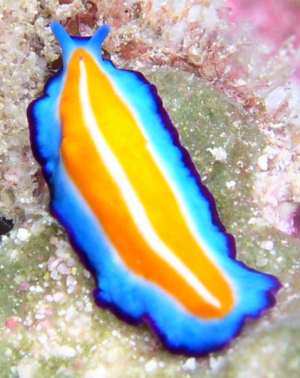
Hi again Bill,
I'm not sure if this is a nudi but it seems to have rhinophores!
Locality: Kalifushivaru, Kuredu, Maldives 23 April 2005, 19 metres.
Charles Rowe
billr@seaslugforum.net
Rowe, C., 2005 (May 27) Flatworm from the Maldives. [Message in] Sea Slug Forum. Australian Museum, Sydney. Available from http://www.seaslugforum.net/find/13869Dear Charles,
It is a flatworm, possibly a Pseudoceros sp. Many flatworms have permanent or semi-permanent folds forming tentacles like this.
Best wishes,
Bill Rudman
Unknown slug Turks & Caicos
May 10, 2005
From: Lynn Robinson
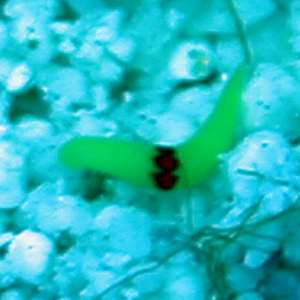
Hi Bill
Hope you can help me identify this little slug...I always find them moving around in the sand in two particular areas in the Turks & Caicos Island...firstly French Cay and recently at North West Point and as yet I have been unable to identify them. They are yellow with black marking around the middle and approx 5mm long.
Locality: Turks & Caicos Islands, Caribbean. Depth: 40 ft. Length: 5 mm. 03 May 2005. sand Photographer: Lynn Robinson
Hope you can help.
Lynn
samlynn001@hotmail.com
Robinson, L., 2005 (May 10) Unknown slug Turks & Caicos. [Message in] Sea Slug Forum. Australian Museum, Sydney. Available from http://www.seaslugforum.net/find/13739Dear Lynn,
I am pretty sure these are flatworms rather than sea slugs. Flatworms crawl quite a lot faster than sea slugs, but it's a bit hard to use comparative characters like that. What you'll have to check is whether there are any signs of body structures. If this were a sea slug it would most likely be an aglajid of some sort, such as Chelidonura africana. If so, there would be parapodial flaps and the body would be divided into a head shield and a posterior or visceral part. If you can't see any such shapes, then I am pretty sure this is a flatworm - perhaps even one that species of Chelidonura eat!
Best wishes,
Bill Rudman
Yellow-spotted nudi from Red Sea
February 22, 2005
From: Henrik From
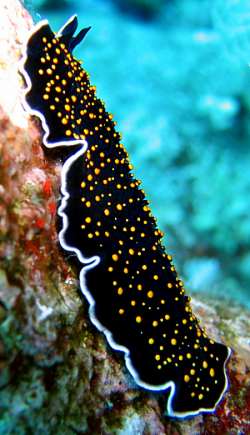
I have never seen this nudi before (after 100+ dives in the Red Sea). This time I saw three. I hope you could assist IDing it.
Locality: Coral Reef, Egypt, Red Sea. Depth: app. 20 m. Length: app. 50 mm. 3 February 2005. Photographer: Henrik From
Best regards,
Henrik From
henrik_from@hotmail.com
Henrik From, 2005 (Feb 22) Yellow-spotted nudi from Red Sea. [Message in] Sea Slug Forum. Australian Museum, Sydney. Available from http://www.seaslugforum.net/find/13191Dear Henrik,
This is in fact a Flatworm. Have a look at the Fact Sheet for more information. I am not an expert on the group but I think it is an unnamed species of Thysanozoon. which has been reported from the western Pacific.
Best wishes,
Bill Rudman
Flatworm? from South Africa
February 18, 2005
From: Charles Rowe
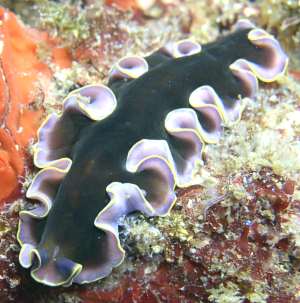
Hi Bill,
I felt sure I sent this one to you but maybe I didn't! Originally I thought it was Leminda millecra but now I think it is a flatworm. Can you identify it? Taken at Bellbuoy, Port Elizabeth, South Africa.
Thanks.
Charles....
Charles.Rowe@gmsa.com
Rowe, C., 2005 (Feb 18) Flatworm? from South Africa. [Message in] Sea Slug Forum. Australian Museum, Sydney. Available from http://www.seaslugforum.net/find/13167Dear Charles,
It certainly looks a bit like Leminda but is definitely a flatworm. Sorry but I won't attempt an identification
Best wishes,
Bill Rudman
Flatworm mimic of Chromodoris africana
January 28, 2005
From: Charles Rowe
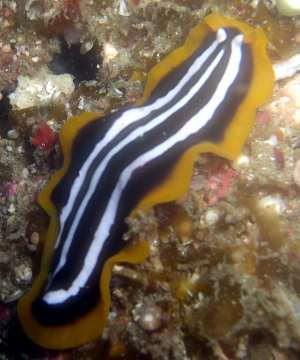
Hi Bill,
Can you identify this nudi from Mozambique please?
Dereks Reef - Ponto Malongame - Mozambique - 26 November 2004 -18
metres
Charles
Charles.rowe@gmsa.com
Rowe, C., 2005 (Jan 28) Flatworm mimic of Chromodoris africana . [Message in] Sea Slug Forum. Australian Museum, Sydney. Available from http://www.seaslugforum.net/find/13046Dear Charles,
This is one of those tricky flatworms, which have clearly evolved to confuse nudibranch fanciers! It looks very like Chromodoris africana in colour pattern, and both have distasteful chemicals in their skin. It is nice to think that it and the flatworm have evolved to look alike - perhaps to protect each other from predators - but at present we have no evidence to support the idea. There are a number of nudibranchs and flatworms which appear to mimic each other like this. Have a look at the Fact Sheet on Aposematic colouration for some background information.
Best wishes,
Bill Rudman
Unknown Mediterranean sea slug
December 24, 2004
From: MIha Frlec
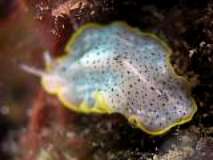
Could you please help me identify this sea slug. It was photographed in the Adriatic on Croatian coast near Rijeka. Depth about 10m, sandy bottom. Length of the slug arround 5cm.
Thanks,
Best regards,
Miha Frlec
miha.frlec@adacta.si
Frlec, M., 2004 (Dec 24) Unknown Mediterranean sea slug. [Message in] Sea Slug Forum. Australian Museum, Sydney. Available from http://www.seaslugforum.net/find/12620Dear Miha,
It is sometimes difficult to distinguish nudibranchs from marine flatworms. I am pretty sure your animal is the euryleptid flatworm Prostheceraeus moseleyi Lang, 1884
For futher information on these animals have a look at Wolfgang Seifarth's website Marine Flatworms of the World at http://www.rzuser.uni-heidelberg.de/~bu6/index.html.
Best wishes
Bill Rudman
Flatworm from Papua New Guinea
July 9, 2004
From: Stéphan Bonneau
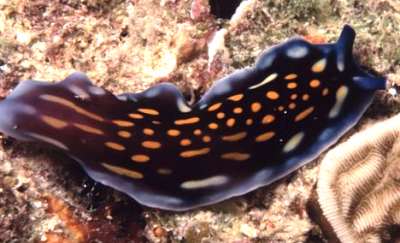
Dear Sir,
Have you any idea about this species of undersea flat worm ? I think it was in Papua Barat (Papua New Guinea)
Best regards
Stéphan Bonneau
s.bonneau@tele2.fr
Bonneau, S., 2004 (Jul 9) Flatworm from Papua New Guinea. [Message in] Sea Slug Forum. Australian Museum, Sydney. Available from http://www.seaslugforum.net/find/12685Dear Stéphan,
This is Psudoceros lindae which is found throughout the Indo-West Pacific. Some marine flatworms look very similar in colour to species of nudibranchs. This species, for example, is similar in colour to a group of blue chromodorid species, inclusing Hypselodoris infucata, Hypselodoris kanga.
Best wishes
Bill Rudman,
Flatworm from Sth Africa.
February 21, 2004
From: Riaan Marx
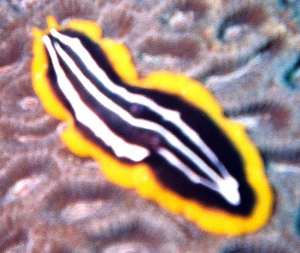
Hi Bill.
I photographed this animal at Sodwana, South Africa. After hours of searching I still could not find an identification ... could you please assist?
Thanks!
Riaan
rmarx@ms.cs.co.za
Marx, R., 2004 (Feb 21) Flatworm from Sth Africa.. [Message in] Sea Slug Forum. Australian Museum, Sydney. Available from http://www.seaslugforum.net/find/12259Dear Riaan,
I'm afraid this is a flatworm, probably a species of Pseudoceros, which looks very like a nudibranch, in particular those species of Chromodoris such as Chromodoris africana with longitudinal black stripes. The apparent rhinophores at the front are specialised folds of the edge of the body. One simple way to identify flatworms in the field is that they glide along much faster than nudibranchs, so if you see a very fast slug it pays to be suspicious.
Best wishes
Bill Rudman
Flatworm from Kenya
February 14, 2004
From: Iwan Bruneel
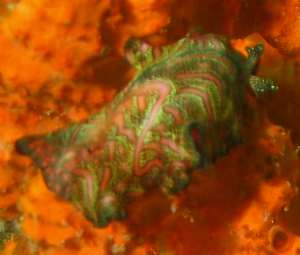
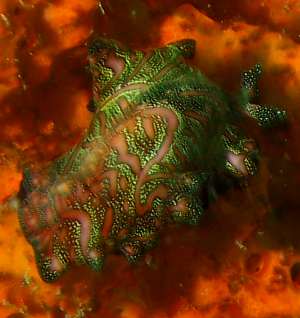
Dear Bill Rudman,
Last january I went to Kenya, Africa for diving in the Indian Ocean. In one of my last dives I came across a slug I could not recognise. I hope you make something of it. Is it Hexabranchus?
I hope you can help me.
Thanks anyway
Iwan Bruneel
the Netherlands
hb.iwanbruneel@kabelfoon.nl
Bruneel, I., 2004 (Feb 14) Flatworm from Kenya. [Message in] Sea Slug Forum. Australian Museum, Sydney. Available from http://www.seaslugforum.net/find/12215Dear Iwan,
This is one of the colourful polyclad flatworms which look very like sea slugs. This species is Pseudobiceros bedfordi (Laidlaw, 1903), and it is found throughout the tropical Indian and West Pacific Oceans. It has a pair of pseudotentacles at the head end which look like a nudibranch's rhinophores. As well as gliding quickly over the substrate it is often seen swimming, like the nudibranch Hexabranchus sanguineus by undulating its whole body.
Best wishes
Bill Rudman
Flatworm from Philippines
February 1, 2004
From: Jean-Jacques Meusy
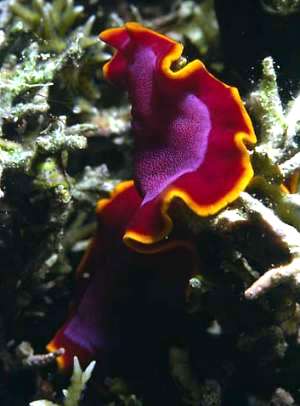
Hello!
Do you think that this sea slug which has been shot in Philippines could be Hexabranchus sanguineus?
Thanks for your help.
Jean-Jacques Meusy
jm_afrhc@club-internet.fr
Meusy , J., 2004 (Feb 1) Flatworm from Philippines. [Message in] Sea Slug Forum. Australian Museum, Sydney. Available from http://www.seaslugforum.net/find/12062Dear Jean-Jacques,
This is in fact a Flatworm, many of which are often mistaken for nudibranchs. Some even have folds and tentacles on their heads which look quite like a nudibranchs rhinophores. By chance we already have a photo of this species, Pseudoceros ferrugineus, on the Forum. Although it is of Indo-West Pacific origin it has been found in Italian waters, perhaps a Lessepsian migrant through the Suez Canal, or perhaps through the careless activity of someone in Italy with a saltwater aquarium. See Sergio Nardini's message.
Best wishes
Bill Rudman.
Flatworm or nudibranch? from East Malaysia
September 4, 2003
From: Mabel Fang
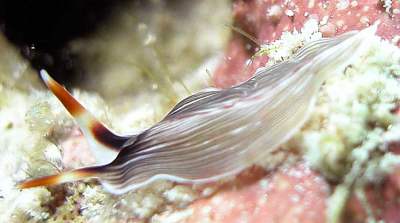
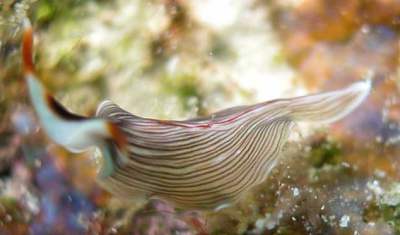
Hi Bill
At first glance, this looked like a juvenile Thuridilla to me but when viewed more closely, it looked like a flatworm.
Could you please identify it? Thanks.
Length: 2cm
Depth: 35 ft
Date: 11 Aug 2003
Location: Kapalai, East Malaysia
Regards
Mabel Fang
barramundi@mac.com
Fang, M., 2003 (Sep 4) Flatworm or nudibranch? from East Malaysia . [Message in] Sea Slug Forum. Australian Museum, Sydney. Available from http://www.seaslugforum.net/find/10900Dear Mabel,
It certainly looks at first glance like a sacoglossan, but as you suspected it is a flatworm.
Best wishes
Bill Rudman
Flatworm from Tunisia
July 30, 2003
From: J. Ben Souissi and A. Eters
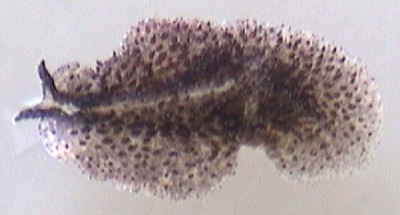
Dear Bill,
Here is another sea slug from our coastal lagoon, "Lac de Tunis" [south section] in Tunis, Tunisia, North Africa. Depth: 0 to 1m some time between January and March, 2003.
Can you identify it please.
Thanks,
Jamila Ben Souissi and Anis Eters
mal_de_toi@cybercartes.com
Ben Souissi, J. & Eters, A., 2003 (Jul 30) Flatworm from Tunisia. [Message in] Sea Slug Forum. Australian Museum, Sydney. Available from http://www.seaslugforum.net/find/9887Dear Jamila & Anis,
Although looking very slug-like this is a flatworm
Best wishes,
Bill Rudman
Flatworms? from Red Sea
July 4, 2003
From: Michael Mrutzek
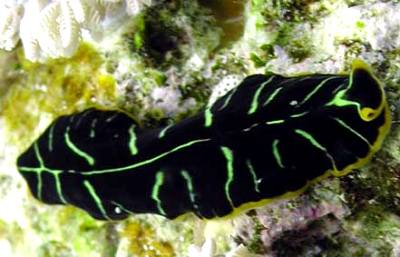
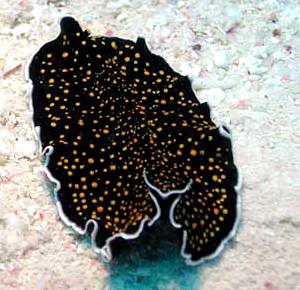
Dear Bill
I am sending some photos of animals I photographed in the Red Sea in May, 2003. Are these 2 different kinds of Flat worms? or arminid nudibranchs?
Michael Mrutzek
Michael@meeresaquaristik.de
Mrutzek, M., 2003 (Jul 4) Flatworms? from Red Sea. [Message in] Sea Slug Forum. Australian Museum, Sydney. Available from http://www.seaslugforum.net/find/10040Dear Michael,
These are flatworms
Cheers
Bill Rudman
Flatworm from Malaysia
April 25, 2003
From: Kelvin Tan
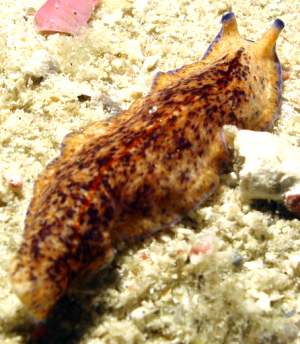
I could not find the name for this sea slug.
Found at Tioman Island, Malaysia
9th March 2003
Depth: 8m
Time: 7:50pm
Kindly please help.
Thanks
Kelvin Tan
lanxx@pacific.net.sg
Dear Kelvin.
This is a Flatworm. The 'tentacles' at the front are formed from folds of the edge of its flat body.
Best wishes,
Bill Rudman
Is this a flatworm or a nudibranch?
April 11, 2003
From: Tina Owens
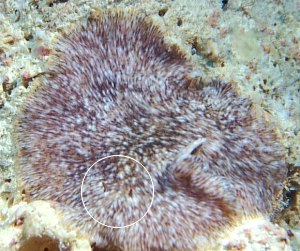
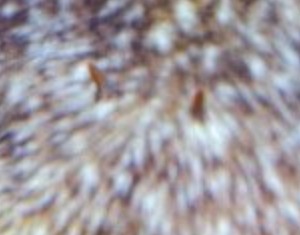
Last Sunday (March 23, 2003) I found this creature under a rock at about 25 feet on the Kona Coast of the Big Island of Hawaii. When it started moving it moved quite quickly and I only got two photos of it. I had never seen anything like it before. When my photos were developed, I realized that the creature has rhinophores. From what I know about flatworms, they only have pseudodentacles near the margin of the head area. This creature has two, clear, orange-colored rhinophores about 1/3 of the way back from the edge. No gills are visible, however. It was about 2" long and flowed over the rock like flatworms do. I have seen no photos of this among any of the collections of Hawaiian flatworms. Or nudibranchs for that matter.
Any help in identifying what it may be will be helpful.
Tina Owens
bob-tinaowens@hawaii.rr.com
Owens, T., 2003 (Apr 11) Is this a flatworm or a nudibranch?. [Message in] Sea Slug Forum. Australian Museum, Sydney. Available from http://www.seaslugforum.net/find/9511Dear Tina,
This is definitely a flatworm. Some do have head tentacles like this, and they do look like a rhinophore. Have a look at the Flatworm pages for links to more information. As a rule of thumb flatworms move quite a bit faster than nudibranchs, gliding over the surface quite rapidly. The other thing that distinguishes them is that they are have no separation into mantle and foot which you can always see in dorid nudibranchs which they look most similar to. Despite that I often feel obliged to pick up flatworms, even though I know they're flatworms - beause you never know when one may be a tricky nudibranch.
Best wishes,
Bill Rudman
Re: Sea Slug from the Red Sea
March 6, 2003
From: Mark Burnett
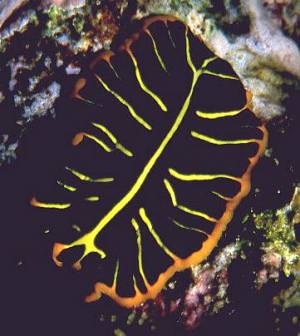
Hi Bill,
Not sure if this is relevant but when I read Aline Flemming's message earlier today I was reminded of a picture I took in the Red Sea way back in April 1994. At the time I thought it was a nudibranch but soon found I was mistaken. I have since found many flatworms that could be mistaken for nudibranchs from their colours but obviously they lack gills and rhinophores. This picture is of Pseudoceros cf. dimidiatus as identified on Wolfgang Seifaith's Marine Flatworms of the World site. It was taken at Al Nakheel, a resort just north of Jeddah, Saudi Arabia. The only thing that puzzles me is the mention of eyes, otherwise the colours fit Aline's description. It looks like Reticulidia halgerda.
Mark Burnett
mburnett@actrix.gen.nz
Burnett, M., 2003 (Mar 6) Re: Sea Slug from the Red Sea. [Message in] Sea Slug Forum. Australian Museum, Sydney. Available from http://www.seaslugforum.net/find/9348Dear Mark,
I think this is an excellent solution to the puzzle. I agree the eyes are a bit of a puzzle - but they are not easily seen in most nudibranchs either - so it is possible Aline is describing a couple of black spots.
Best wishes,
Bill Rudman
I think these are small nudibranchs?
March 5, 2003
From: Kevin Hartley
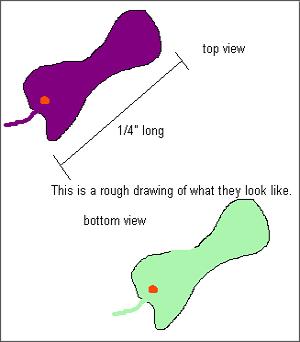
I have these small things in my tank. They are about 1/4" long about 1/8" wide. Purple on top green on bottom with a red/orange dot on their back. They have a small tail that is 1/8"long. They seem to multiply by laying orange clumps of eggs and by division. They will grow a flap off of the back of themselves and it will break off into a smaller one. I think that these are nudibranchs but I would like to know for sure. I would also like to know the specific species and stuff so that I can learn about this particular one on the net. Thanks for all replies.
Kevin Hartley
khartley@envproduct.com
Hartley, K., 2003 (Mar 5) I think these are small nudibranchs?. [Message in] Sea Slug Forum. Australian Museum, Sydney. Available from http://www.seaslugforum.net/find/9305Dear Kevin,
Your animals are acoel flatworms which usually reproduce by budding or 'fission' just as you describe. By chance I found a message in the queue which completely answers your question. Have a look at Mike Noren's message. Although not quite as colourful as your sketches, his flatworms have the little tail and the orange spot. Follow some of the links to earlier messages where Acoel flatworms are discussed.
Best wishes,
Bill Rudman
Sea Slug from Red Sea
March 5, 2003
From: Aline Flemming
I saw a slug in the Red Sea, 22 Feb 2003. Until now I can't find it's name. I have looked in the Forum but as I don't know the name it is not easy to find. I hope you can help me.
6-7cm long small black body with orange fine line round the body and also his eyes. From the edge of the body small yello/citron colour lines of 1 cm, all over the body.
We were diving round Hurgharda at Sharm el Naga round 10-15 m and he was sitting on coral. (water temp 22 C)
Aline Flemming
Holland
aflemming@hydron-mn.nl
Flemming, A. , 2003 (Mar 5) Sea Slug from Red Sea. [Message in] Sea Slug Forum. Australian Museum, Sydney. Available from http://www.seaslugforum.net/find/9337Dear Aline,
One of the problems with the Forum is the difficulty in searching through all the species for identifications. We are in the process of developing a couple of identification keys which should help that problem.
Concerning your animal. It is quite difficult to identify even the most common species without a photo or drawing. There is also the possibility your animal was not a sea slug but perhaps a Flatworm, many of which are quite brilliantly coloured. The only sea slug I can think of with the colours you describe, and which would grow to 6-7cm would be Reticulidia halgerda, but that species is at present only known from the western Pacific. That is not to say it might not also occur in the Red Sea, but we would need at least a photo to confirm it. One observation of yours that suggests your animal was a phyllidiid [which is the family Reticulidia belongs to] is your observation that it was sitting on a coral. The phyllidiids, presumably because of the distasteful chemicals they exude from their skin are one of the few groups of nudibranchs that are found sitting out in the open during the day.
However without a photo I can only really guess at what you found
Best wishes,
Bill Rudman
Acoel flatworms in aquaria
March 5, 2003
From: Mike Noren
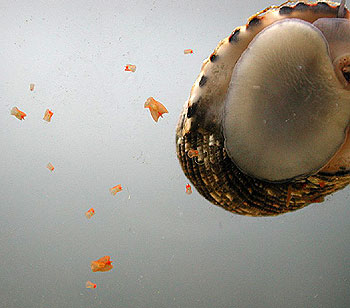
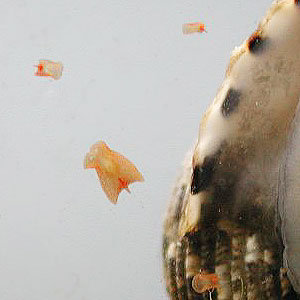
I saw the page on the acoel flatworms which occasionally show up in reef aquaria, and are mistaken for nudibranchs... I can not identify the acoels pictured, although that type of acoel tend to be small predators of copepods, other small flatworms etc.
The most common type of acoel to show up in reef tanks is probably the brick-red to orange Convolutriloba sp. (usually referred to Convolutriloba retrogemma, but I suspect several species occur). Convolutriloba and some other acoels reproduce primarily asexually, by fission, and I've attached a picture showing the densities these worms can attain in aquaria with strong light (they have symbiotic algae) and abundant copepod prey. The picture shows a typical section of the front pane, about 4x3cm, of a heavily infested aquarium.
They are not parasitic, but can reportedly damage corals by shading. At present no easily available predator of these worms is known, although I would speculate that the white star-trek symbol shaped acoels pictured on the flatworm page would probably eat them.
Normally, however, the worms disappear on their own accord after a few months, presumably after having exhausted some necessary nutrient. There have been some recent developments regarding Convolutriloba in aquaria - specifically two antihelminth drugs have been released, which can be used to destroy these worms with 'fairly' mild repercussions to fish and corals.
Mike Noren
mike_noren@hotmail.com
Noren,M., 2003 (Mar 5) Acoel flatworms in aquaria. [Message in] Sea Slug Forum. Australian Museum, Sydney. Available from http://www.seaslugforum.net/find/5836Dear Mike,
Thanks very much for the information and the photos. Your message is, by chance, an excellent answer to another one I am posting today from Kevin Hartley.
Best wishes,
Bill Rudman.
Flatworm from Turkey
January 14, 2003
From: Ferda Buyukbaykal
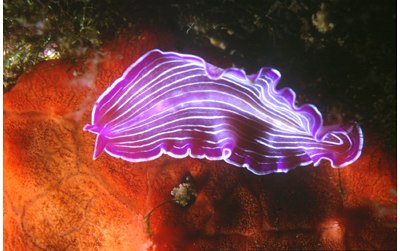
Dear Bill,
Could you identify this photo?
Data: Saroz-Canakkale, Turkey. July, 2002, bebek kayaligi, 15mt on algae, covered rocky.
Best wishes
Ferda
ferdabbaykal@isnet.net.tr
Buyukbaykal, F., 2003 (Jan 14) Flatworm from Turkey. [Message in] Sea Slug Forum. Australian Museum, Sydney. Available from http://www.seaslugforum.net/find/8889Dear Ferda,
This is certainly beautiful enough to be a nudibranch,, but it is a Flatworm, possibly Prostheceraeus roseus. I am not however an expert on their identification so you would need to check the name.
Best wishes,
Bill Rudman
Nudibranch? from Sydney
December 23, 2002
From: Allan Saben
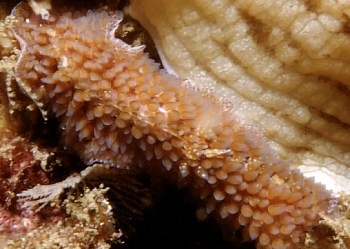
I wonder if you could please identify this species.
Image Data:
Taken at North Head Lighthouse, Sydney, NSW
Depth 18 meters
Macro 1:1
Allan Saben
asaben@bigpond.net.au
Saben, A., 2002 (Dec 23) Nudibranch? from Sydney. [Message in] Sea Slug Forum. Australian Museum, Sydney. Available from http://www.seaslugforum.net/find/8413Dear Allan,
This is a Flatworm. Almost certainly the same as in David Harasti's message.
Cheers,
Bill Rudman
Flatworm from Port Stephens (NSW)- Australia
November 30, 2002
From: Dave Harasti
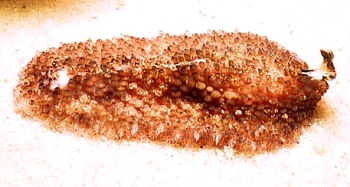
Hi Bill,
A big thanks for all your help in the ID of the species that I find, the Seaslug Forum is my number 1 nudibranch resource! I have attached a photo of an animal that I cannot identify. This animal was found at an isolated reef in Port Stephens, NSW - Australia in November 2002 in about 8 metres of water. Water temp was about 16 degrees.
Could you please help with any possible identification, I was actually considering that it could be a flatworm?
Cheers,
Dave
diving@webone.com.au
Harasti, D., 2002 (Nov 30) Flatworm from Port Stephens (NSW)- Australia. [Message in] Sea Slug Forum. Australian Museum, Sydney. Available from http://www.seaslugforum.net/find/8452Dear Dave,
This is one of those flatworms which are sent to trick us. The papillae on its back certainly look quite like the cerata of some nudibranchs
Best wishes,
Bill Rudman
Slugs? Worms?
July 6, 2002
From: Helmut Schirmböck
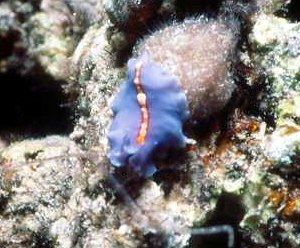
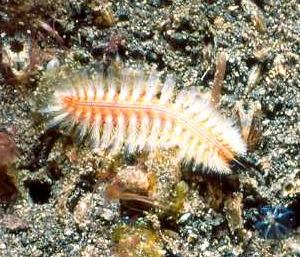
Dear Bill
Can you please gve me some idea what these are please? slug or worm?
Both were taken in the Bunaken Is - Lembeh Strait region of Nth Sulawesi, Indonesia,
Helmut
schirmis@aon.at
Schirmböck, H. , 2002 (Jul 6) Slugs? Worms?. [Message in] Sea Slug Forum. Australian Museum, Sydney. Available from http://www.seaslugforum.net/find/7404Dear Helmut,
Neither of these are slugs. The upper one is a Flatworm, which often are as brilliantly coloured as nudibranchs and the lower one is another worm, quite unrelated to flatworms. They are called 'bristle' worms or polychaete worms because of the fine bristles they have arranged in bundles down each side of their body. As much as I would like to discuss these animals in more detail, I am afraid I don't even have enough time to answer all the sea slug messages I receive.
Cheers,
Bill Rudman
Unknown from Indonesia
July 6, 2002
From: Erwin Köhler
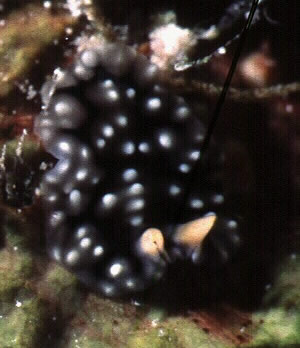
Dear Bill,
Here is a shot by Britta Hochberger (email
Britta.Hochberger@t-online.de) from Indonesia, Kakaban Island, divesite "Gorgonian Forest". Do you have any idea on this one?
Size: 1 cm
Depth: 15M
Date:19 April 2002
Cheers,
Erwin
Erwin@medslugs.de
Köhler, E., 2002 (Jul 6) Unknown from Indonesia. [Message in] Sea Slug Forum. Australian Museum, Sydney. Available from http://www.seaslugforum.net/find/6953Dear Erwin,
If you look carefully you can see that the head tentacles are folds of the notum. I am pretty sure this is a Flatworm. Perhaps one of the species that mimics phyllidiids.
Best wishes,
Bill Rudman
Thysanozoon nigropapillosum from west Malaysia
June 29, 2002
From: Kheong Sann Chan
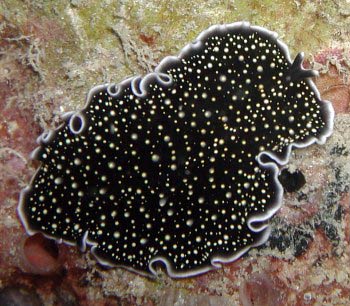
Here is another nudibranch from Pulau Dayang off the east coast of west Malaysia.
Location: Pulau Dayang, Dayang house reef
Date : 9 June, 0800
Depth : 8m
Kheong Sann Chan
kschan@mail.dsi.nus.edu.sg
Chan, K.S., 2002 (Jun 29) Thysanozoon nigropapillosum from west Malaysia. [Message in] Sea Slug Forum. Australian Museum, Sydney. Available from http://www.seaslugforum.net/find/7221Dear Kheong,
This is a flatworm. Most probably Thysanozoon nigropapillosum. Have a look at the Flatworm pages for more information on these often beautiful animals - which can easily be mistaken for nudibranchs.
best wishes,
Bill Rudman
Re: Is this a nudibranch or a flatworm?
June 1, 2002
From: Leslie Newman
This is definitely a flatworm, either Acanthozoon sp. (1 male pore) or Thysanozoon sp. (2 male pores). You have to turn them over to check out the gonopores. This is most likely a new species.
Cheers,
Dr Leslie Newman
Southern Cross University,
Australia
leslien@dnet.aunz.com
Newman, L., 2002 (Jun 1) Re: Is this a nudibranch or a flatworm?. [Message in] Sea Slug Forum. Australian Museum, Sydney. Available from http://www.seaslugforum.net/find/7130Thanks Leslie,
Bill Rudman
Re: Is this a nudibranch or a flatworm?
May 28, 2002
From: Lindsay Warren
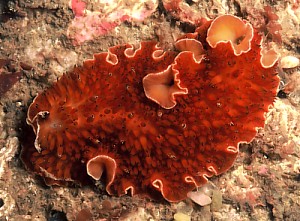
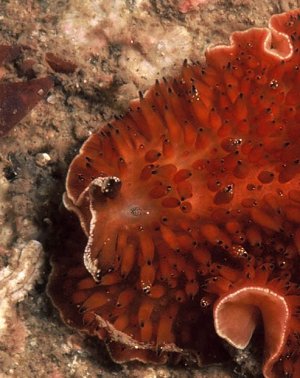
Dear Bill
I was interested to see the photo Valda sent through to you.
Please find attached a photo of a similar flatworm I found at low tide in the rock pools at Pumula, KwaZulu-Natal, South Africa on 18 December 2001 when rock-pooling with Valda. I think it might be the same species.
The anterior end with pseudotentacles and dorsal papillae are a little clearer but pretty much the same as in Valda's photo.
Length: 30mm.
All the best
Lindsay
alldcl@compuserve.com
Warren, L., 2002 (May 28) Re: Is this a nudibranch or a flatworm?. [Message in] Sea Slug Forum. Australian Museum, Sydney. Available from http://www.seaslugforum.net/find/6991Thanks Lindsay,
It is indeed a flatworm.
Cheers,
Bill
Is this a nudibranch or a flatworm?
May 15, 2002
From: Valda Fraser
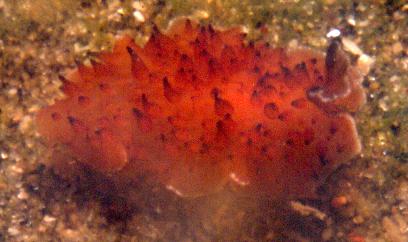
Dear Bill
I didn't know whether I should send you this image or not. I think it may be a flatworm, but what about the protrusions covering the body? Not the best image!
Regards
Valda Fraser
valdafraser@mweb.co.za
Fraser, V., 2002 (May 15) Is this a nudibranch or a flatworm?. [Message in] Sea Slug Forum. Australian Museum, Sydney. Available from http://www.seaslugforum.net/find/5841Dear Valda,
At first thought I suspected a Flat worm, and I suspect that is what it is, but what looks to be a head tentacle [or rhinophore?] at the front makes me wonder if it is a strange arminoidean of some sort.
Best wishes,
Bill Rudman
photo- and geotaxis in Planaria
February 10, 2002
From: Jamey Assid
Dear Bill,
I am a college student doing research on Planaria for a biology class. I have failed to find much info on the behavior of Planaria inregards to gravity. I read more about phototaxis but not anything I found had any dealings with geotaxis. Hoping you could help me out.
Thanks,
Jamey Assid
jlassid@hotmail.com
Assid, J., 2002 (Feb 10) photo- and geotaxis in Planaria. [Message in] Sea Slug Forum. Australian Museum, Sydney. Available from http://www.seaslugforum.net/find/6205Dear Jamey,
As much as I would like to answer questions on flatworms and other invertebrates, I have more than enough 'sea slug' questions to keep me busy day and night. However your question does give me the chance to demonstrate the wonders of modern search engines on the web such as google.com.
If you go there and type planaria geotaxis you will find three or four references which should meet your needs.
Good Luck with your project,
Bill Rudman
Need information about flatworms
December 1, 2001
From: Tanya
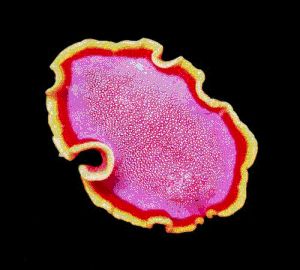
Hi,
I need some more imformation on a flat worm species called Pseudoceros ferrugineus for a school report. If you have any sites on this species or even and other types. I would really appreciate it.
Thanks!
Tanya
mochastar14@hotmail.com
Tanya, 2001 (Dec 1) Need information about flatworms. [Message in] Sea Slug Forum. Australian Museum, Sydney. Available from http://www.seaslugforum.net/find/5763Dear Tanya,
As the name suggests, this is a site for sea slugs not flatworms, but I do have a little information on flatworms because they are often mistaken for nudibranchs. Yu are also in luck because we recently had a message from Italy about the very flatworm you are interested in, which seems to have found it way to Italy by some artificial means as it is a native of the Indian and Pacific Oceans.
If you look at theat message you will see a reference to a good flatworm site.
Best wishes,
Bill Rudman
Re: flatworm mystery
December 1, 2001
From: Steven Scott
Bill,
Thank you very much for your help. That is what it is. I wish I had a digital camera so I didn't have to make "drawings"... someday...
Thank you again,
Steven
forever.tteot@verizon.net
Scott, S., 2001 (Dec 1) Re: flatworm mystery. [Message in] Sea Slug Forum. Australian Museum, Sydney. Available from http://www.seaslugforum.net/find/5765Help in IDing worm/snail-like creature
November 30, 2001
From: Steven
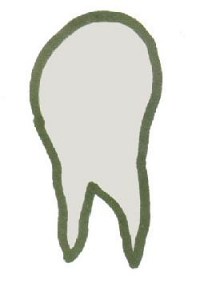
Hi,
I will first apologize for my bad drawing, but I couldn't find anything on the net that looked like what I have in my tank. This morning I noticed on the back wall of my tank maybe a dozen of these worm-like things crawling around on the glass. They are about 3/16" long and maybe 3/32" wide and at most 1/16" thick. They are whitish/beigish with very faint brownish specs on it. It is round on the front and has a forked tail. It's movement was very much like a snail and it's front end raises slightly and comes down on the glass like it is catching something.
I hope this sounds familiar to someone so I can figure out what these are. I thought they were Flatworms, but every pic that I have looked at, they are colorful and basically oval ... no forked tailend.
DRAWING (not very good, but I tried)
Thank you for your help,
Steven
forever.tteot@verizon.net
Steven, 2001 (Nov 30) Help in IDing worm/snail-like creature. [Message in] Sea Slug Forum. Australian Museum, Sydney. Available from http://www.seaslugforum.net/find/5742Dear Steven,
Your drawing's not bad and certainly illustrates the basic shape. I am pretty sure your animals are Acoel flatworms. Have a look at Haruo Kinoshita's message and Michelle Catalano's
message for photos of these forked-tail flatworms which look just like your drawing. They often occur in large numbers on soft corals and sponges so possibly that is how they got into your aquarium - on some recent addition.
best wishes,
Bill Rudman
Spanish Dancer? from Italy
October 11, 2001
From: Sergio Nardini
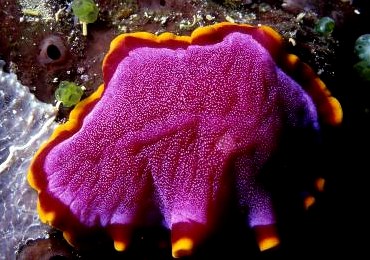
Dear friends,
i'm writing from Rome, Italy. Please, find the attached ... is a photo of a spanish dancer, I think, i have taken in the Mediterranean sea. Exactly in Santa Marinella, Lazio, about 50 km from Rome. Depth about 20 mt, night dive... I can't find any kind of nudibranco like this one. Can you tell me something about?
Thanks for your reply,
Best regards, ciao.
Sergio Nardini
Roma
sergio.nardini@aruba.it
Nardini, S., 2001 (Oct 11) Spanish Dancer? from Italy. [Message in] Sea Slug Forum. Australian Museum, Sydney. Available from http://www.seaslugforum.net/find/5443Dear Sergio,
Although it certainly looks spectacular enough to be the Spanish Dancer, Hexabranchus sanguineus it is in fact a polyclad flatworm, a group which are often mistaken for nudibranchs. Have a look at the other photos of flatworms on this page. It will give you some idea of the variation to be found.
Although it is not a nudibranch, I think I recognise your flatworm as Pseudoceros ferrugineus Hyman, 1959. If I am correct then it is a long way from home because that species is only known from the tropical Pacific and eastern Indian Ocean. Perhaps you have an invader from the Pacific in your waters. You might like to send your photo to Wolfgang Seifarth at his "Marine Flatworms of the World" Site [at http://www.rzuser.uni-heidelberg.de/~bu6/index.html].
I would be interested in photos you have of nudibranchs you see on your dives. It would be nice to have some nudibranchs from Rome on the Forum.
Best wishes,
Bill Rudman
Re: Dancing Through Life
May 22, 2001
From: Jeffery Jenner
I too had an experience with a swimming Flatworm in Truk lagoon the creature was sitting on some coral growing on a handrail about 10 inches long & 2 1/2 wide ( Yes it was big ) I videotaped the whole sequence it was magenta in color with a blue stripe ringing the outside when it "swam" the head reared up & it launched itself rippling the sides in a ribbon manner quite easily changing direction, first I followed it aprox 3 feet away then it turned & followed me all the while doing barrel rolls & generally showing off swiming about 2 miniuts & 30 seconds aprox 15 feet in distance before doubling back landing in the same area it started from December 30th, 85 feet deep 83 degrees water temp. Sorry I am not computer literate enough to send a MPG file or even a frame but it is quite a piece of tape & yes I do love nudies & flatworms !
I am a DM living in the Monterey Bay area [California] with aprox 500+ dives all over the world our cold water nudies are still some of the best in the world
Jeffery Jenner
jeff@jjmetal.com
Jenner, J., 2001 (May 22) Re: Dancing Through Life. [Message in] Sea Slug Forum. Australian Museum, Sydney. Available from http://www.seaslugforum.net/find/4384Dear Jeffery,
Lucky your message mentioned nudibranchs in the last sentence or I would have had to discard it. Despite their beauty, I don't have the time to include flatworms on the Forum.
Best wishes,
Bill Rudman
Dancing Through Life
May 10, 2001
From: Walabha Sinbul
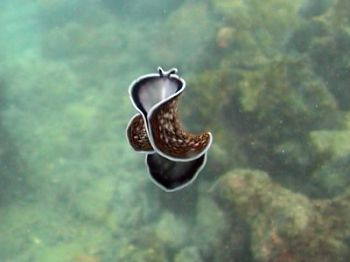
Dear Bill,
May be you're interested in identifying this dancing flatworm too. It is from Samed Island, Thailand. The water is about 1.5 m. deep. Too bad the water is kind of murky. I've heard that a flatworm can swim only for a short distance when disturbed. It might not be true for my animal. It went on "dancing" like this for about 10 minutes without any attempt to land. (May be this one has been disturbed a lot before we met it!)
Best wishes,
Walabha
walabha@hotmail.com
Sinbul, W., 2001 (May 10) Dancing Through Life. [Message in] Sea Slug Forum. Australian Museum, Sydney. Available from http://www.seaslugforum.net/find/4265Dear Walabha,
What an excellent photo! I'll add it to the Flatworm pages because it is a nice comparison with the various swimming sea slugs. I'm not a flatworm expert but Wolfgang Seifarth is and his "Marine Flatworms of the World" Site at http://www.rzuser.uni-heidelberg.de/~bu6/index.html is well worth a visit. If you contact him he may be able to identify your swimmer.
Best wishes,
Bill Rudman
Flatworm? from New Zealand
March 15, 2001
From: Gareth Jones
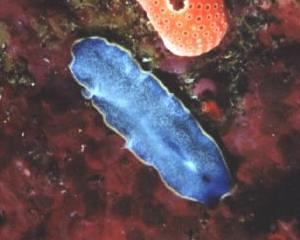
Hi Bill,
I found this on 20 Feb at the Poor Knights Islands [northeastern New Zealand] at a depth of 15m. There were two of them about 30cm apart. size 1cm. travelling at quite high speed, perhaps late for a meeting.
Regards,
Gareth Jones
rees@divenz.co.nz
Jones, G., 2001 (Mar 15) Flatworm? from New Zealand. [Message in] Sea Slug Forum. Australian Museum, Sydney. Available from http://www.seaslugforum.net/find/3893Dear Gareth,
All I can say is that it is definitely a flatworm. Apart from its 'two-dimensional' appearance, your mention of its 'high speed' seems to cancel out sea slugs. Despite my love of sea slugs, they are definitely slow - 'sluggish' in fact.
Cheers,
Bill Rudman
Possible Chelidonura from Japan
October 25, 2000
From: Haruo Kinoshita
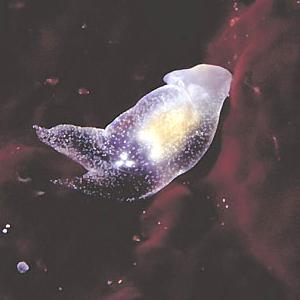
Hello,
The sea animal in the picture was swimming by moving his tails up and down like a hinge at the depth of 12m. I think this is one kind of Chelidonura from his appearance.
Photo: Haruo Kinoshita
Place: Izu Ocean Park, Izu peninsula, Japan
Date: 6/5/2000
Depth: 12m
Temperature: 18c
Length: approx. 10mm
Thank you.
Haruo Kinoshita
shirara@af.airnet.ne.jp
Dear Haruo,
It certainly has the look of a species of Chelidonura with its bifurcating tail but I think it is a
flatworm. Have a look at Atsushi Ono's photo of an acoel flatworm. On a living animal it is easy enough to see the differences as a species of Chelidonura will have a distinct head shield and posterior shield and there will be flaps of the foot (parapodia) folded up on each side of the body. Flatworms on the other hand don't have any noticeable body parts. As their name suggests they are basically flat, relatively thin, featureless animals.
Best wishes,
Bill Rudman.
Would love an ID and some info!
June 2, 2000
From: Michelle Catalano
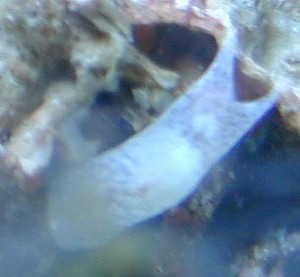
Hmm...this is a picture of something found on some new Fiji rock in my reef tank, not from a dive. Hope I'm not offending anyone by posting in here!
At any rate, I've so far seen 3 of these tiny guys. They range in length from 3-10mm, and 1-3mm in width. They are a translucent white with faint spots and are more opaque in the center. Shape is slug-like rather than flat.
If anyone has any ideas, I'd love to hear them.
Thanks!
Michelle
mchelle@albany.net
Catalano, M., 2000 (Jun 2) Would love an ID and some info!. [Message in] Sea Slug Forum. Australian Museum, Sydney. Available from http://www.seaslugforum.net/find/2484Dear Michelle,
What you have are acoel flatworms, which certainly look like slugs, but on the whole tend to move a bit faster than slugs. For some background information on them go to the Flatworm pages, and in particular have a look at the photo with Atsushi Ono's message.
For more detailed information go to Wolfgang Seifarth's "Marine Flatworms of the World" at
http://www.rzuser.uni-heidelberg.de/~bu6/index.html.
One problem with these flatworms in aquaria is that if they breed they can eat your colonial cnidarians such as hard and soft corals. There are a number of messages concerning this and how to control them in messages on the Chelidonura varians page.
Best wishes,
Bill Rudman.
Orange 'slugs' in fish tank
April 3, 2000
From: Patrick Schellerup
I have come across a very small slug of some sort in my fish tank. It very closely resembles a small red/orange mushroom about 2-3 mm long. They don't move around very much, in fact I did't even think of them as worms until i puled one off the glass and it started crawling around on my finger. They are very prolific, I must have ten of thousands of them in there. Any Ideas what they are?
Patrick Schellerup
hcameron@idt.net
Schellerup, P., 2000 (Apr 3) Orange 'slugs' in fish tank. [Message in] Sea Slug Forum. Australian Museum, Sydney. Available from http://www.seaslugforum.net/find/2174Dear Patrick,
Sounds like a flatworm to me. Have a look at the Flatworm Page and the page on Chelidonura varians, a sea slug which eats flatworms.
Best wishes,
Bill Rudman.
Discodoris? or Flatworm? from Victoria
February 14, 2000
From: David Freemantle
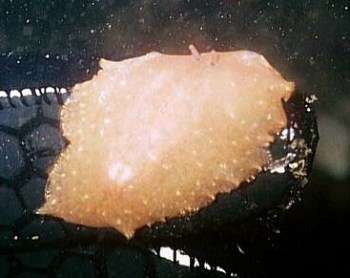
Dear Bill
I wonder if you could help me in the identification of the sea slug in the attached image, taken at Portsea Pier, Port Philip Bay, Victoria (night), 3 years ago. Although not visible in the image, in the original slide there are small / partial extended gills visible next to the large white spot at the rear midline of the animal.
I am sorry there is not much else I can tell you as I only just rediscovered the slide and the memories are long gone.
Thanks,
Regards
David F.
scubadav@rock.upnaway.com
Freemantle, D., 2000 (Feb 14) Discodoris? or Flatworm? from Victoria. [Message in] Sea Slug Forum. Australian Museum, Sydney. Available from http://www.seaslugforum.net/find/1887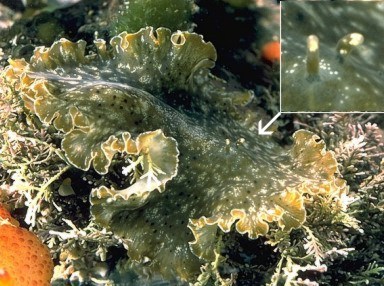
Dear David,
I wonder if the 2 things you can see in the original slide are really gills. My problem is that I have no idea of size, though I suspect 40-50mm wide by the size of the diver's glove.
My feeling is that it is a large flatworm - which wouldn't have gills at the back. Apart from the general shape the pair of small head tentacles clustered closely together at the front of the animal look much more like the head tentacles of a flatworm than a nudibranch. Have a look at my photo of Paraplanocera oligoglena a large flatworm found at least in eastern Australia. In the inset you will see the tentacles I am talking about.
Best wishes,
Bill Rudman.
Address of Marine Flatworms Site changed
January 27, 2000
From: Wolfgang Seifarth
Please note: The URL of the Marine Flatworms of the World! has changed.
The pages can be found now at
http://www.rzuser.uni-heidelberg.de/~bu6/index.html
Dr. Wolfgang Seifarth
Faculty of Medicine, Mannheim,
University Heidelberg
Germany
seifarth@rumms.uni-mannheim.de
Seifarth, W., 2000 (Jan 27) Address of Marine Flatworms Site changed. [Message in] Sea Slug Forum. Australian Museum, Sydney. Available from http://www.seaslugforum.net/find/1800Help! My Xenia polyps are being eaten!
January 23, 2000
From: Rich Staley
Hello,
I work at a retail pet store, and one of my customers approached me with a problem. He had harvested over 50 "sea slugs" that had colonized his aquarium and had feasted on his xenia polyp colony. The slugs are 0.5 cm approximately, white, with a faint green saddle. They apparently have only bothered his Xenia colony, and they do not seem to appear elsewhere in his aquarium. He keeps his tank stocked with Fiji live rock, probably from Walt Smith Inc. His water parameters generally test fine, with a ph around 8.0-8.2 being the only "problem" test. I would provide more info., but this is all I know.
If you can help me, please let me know what these are, what else they might eat.
Thank you,
Rich
tropheus@itis.com
Staley, R., 2000 (Jan 23) Help! My Xenia polyps are being eaten!. [Message in] Sea Slug Forum. Australian Museum, Sydney. Available from http://www.seaslugforum.net/find/1772Dear Rich,
Without some idea of shape, it is difficult to even guess at what your friend has. I guess that because he doesn't mention any papillae, gills or other 'frilly' bits that his animal doesn't have them. My bet then is that he has an infestation of a flatworm rather than of a sea slug. There are a group of acoel flatworms which occur in large numbers on soft corals and other colonial animals. There is a picture of one in a recent message from Atsushi Ono.
If the animals are nudibranchs, the most likely culprits are aeolids such as Phyllodesmium crypticum which live and feed on Xenia and its relatives.
And before you ask - I know of no 'cure'. The animals either came as microscopic larvae on the Xenia or else on the 'live rock'. Xenia have symbiotic algae in their tissues so unless your friend has good plant 'grow lamp' lighting, the Xenia may already be in a fragile state. It may survive, but I guess the important thing is to keep an eye on it and remove it before it starts rotting. If he has acoel flatworms it is posssible they will move to other soft corals he has in his aquaria so he will have to decide whether he wants healthy soft corals or healthy flatworms.
Let me know if my guess is correct
Best wishes,
Bill Rudman.
Aeolid or flatworm?
August 3, 1999
From: Grey McNeil
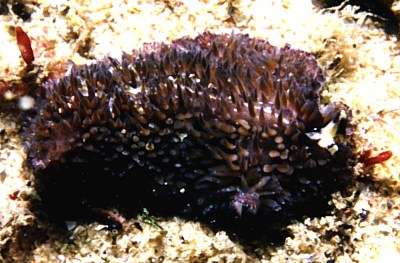
HI BILL,
COULD YOU PLEASE IDENTIFY THIS BEASTY FOR ME. TAKEN AT CAMP COVE [Sydney Harbour, New South Wales] ON 26 July 1999 NIGHT DIVE AT 5 METERS IN AMONGST THE BOTTLES AND RUBBISH.
IT IS ABOUT 2CM LONG
THANKS
GREY MCNEIL
GREYMACIND@BIGPOND.COM.AU
McNeil, G., 1999 (Aug 3) Aeolid or flatworm?. [Message in] Sea Slug Forum. Australian Museum, Sydney. Available from http://www.seaslugforum.net/find/1120Dear Grey,
Although it looks like a nudibranch, this is a polyclad flatworm. Flatworms normally don't have these papillae all over their bodies. There is some general information on flatworms at the Top of this Page and also in the messages below yours on this page. For more detailed information have a look at Wolfgang Seifarth's Flatworm Site, especially the introductory section.
Best wishes,
Bill Rudman.
NOTE: The URL of the Marine Flatworms of the World! has changed to:
http://www.rzuser.uni-heidelberg.de/~bu6/index.html [Jan 2000]
Flatworm from Kerama Island, Japan
June 25, 1999
From: Atsushi Ono

Dear Bill,
Could you help me with another opisthobranch from Kerama Island, near Okinawa.
Is this an opisthobranch? Aglajidae? 2.5m depth, 3mm length, in April, 1999.
This animal moves speedily.
Sincerely,
Atsushi Ono
ononini@cosmos.ne.jp
Ono, A., 1999 (Jun 25) Flatworm from Kerama Island, Japan. [Message in] Sea Slug Forum. Australian Museum, Sydney. Available from http://www.seaslugforum.net/find/974Dear Atsushi,
The clue to this animal is your comment that it 'moves very speedily'. It's usually a good sign that the animal is a flatworm not an opisthobranch. It is an acoel flatworm. Sometimes they occur in very large numbers on their preferred food, sometimes a soft-coral, sponge or large coral colony.
I suspect that these are the type of flatworm that species of Chelidonura feed on.
Best wishes,
Bill Rudman.
Interesting Fact About Flatworms
May 14, 1999
From: Olukayode Akinsola Jr.
I'm doing a little research project, and I need to knwo one interesting fact about flatworms that people will remember. Got any suggestions?
Olukayode Akinsola Jr
akinsola_olu@hotmail.com
Akinsola Jr, O., 1999 (May 14) Interesting Fact About Flatworms. [Message in] Sea Slug Forum. Australian Museum, Sydney. Available from http://www.seaslugforum.net/find/857Dear Olukayode,
I'm afraid I'm not an expert on Flatworms. There is some information on the following two pages and the flatworms mimicking nudibranchs are pretty amazing.
•Flatworms
•Flatworms - mimicry
You will find more information on Wolfgang Seifarth's Flatworm site at
http://www.tauchen.de/homepage/flatworms/index.html.
Best wishes,
Bill Rudman.
NOTE: The URL of the Marine Flatworms of the World! has changed to:
http://www.rzuser.uni-heidelberg.de/~bu6/index.html [Jan 2000]
Re: Flatworm facts
May 14, 1999
From: Olukayode Akinsola
Thanks Bill,
I got what I needed.
Thanks alot.
Olukayode Adebyi Akinsola Jr.
(Double 7)
akinsola_olu@hotmail.com
Akinsola, O., 1999 (May 14) Re: Flatworm facts. [Message in] Sea Slug Forum. Australian Museum, Sydney. Available from http://www.seaslugforum.net/find/864Flatworms!!!!!
May 7, 1999
From: Jessica
I have to do a portfolio on some invertebrates, and one of the many I have to find is the flatworm. However, it is extremely hard to find the Common name, scientific name, size, location, food, description, and 3 other interesting facts, and a good sized picture. HELP!!!!
I went to that site you keep recommending ... it helped me NONE! it doesn't contain the information I need. I need common name, scientific name, size, location, food, and a description, and 3 other interesting facts....I'm getting quite desparate! HELP ME
Jessica
Jmart4@mail.com
Dear Jessica,
I keep on recommending Wolfgang Seifarth's Flatworm site at
http://www.tauchen.de/homepage/flatworms/index.html, because it is an excellent source of information.
NOTE: The URL of the Marine Flatworms of the World! has changed to:
http://www.rzuser.uni-heidelberg.de/~bu6/index.html [Jan 2000]
As well as many excellent photographs - mostly identified with scientific name and locality - it has also has a comprehensive introductory section on flatworm biology, anatomy and natural history.
I am afraid in the real world we can't just pull the 'facts' you require out of a hat n order. It may be possible with birds and mammals, but in the 99% of the world's animals that have no backbone - the invertebrates - we have a lot to learn.
Most invertebrates don't have Common Names either. Apart from common butterflies, moths and pest insects, most common names you see in books are made up by authors at the insistence of publishers who think such names are important.
I am sorry I can't help more. The best lesson you have learnt is how little we know about most of the animals we seem intent on wiping off the face of the Earth.
Bill Rudman.
Rudman, W.B., 1999 (May 7). Comment on Flatworms!!!!! by Jessica. [Message in] Sea Slug Forum. Australian Museum, Sydney. Available from http://www.seaslugforum.net/find/847Need info on flatworms
April 15, 1999
From: Philip
My name is Philip and I need a lot of info on flatworms for a school project . I am in the 7th grade and 12 years old
Philip
SLASH_ALFA@aol.com
Dear Philip,
Although marine flatworms look quite like Sea Slugs they belong to quite a different group of animals. I have a Flatworm page which has some information. Have a look there and at earlier messages about flatworms which are below your message.
For more detailed information go to Wolfgang Seifarth's Flatworm recently updated site at
http://www.tauchen.de/homepage/flatworms/index.html.
Good Luck with your project,
Bill Rudman.
NOTE: The URL of the Marine Flatworms of the World! has changed to:
http://www.rzuser.uni-heidelberg.de/~bu6/index.html [Jan 2000]
New address for Flatworm site
March 15, 1999
From: Wolfgang Seifarth
Dear Dr. Rudman:
As a frequent visitor of the Sea Slug Forum I would like to thank you for recommending my marine flatworm pages to the other participants. I feel very honored .
I am currently updating the marine flatworm pages which are now at:
http://www.tauchen.de/homepage/flatworms/index.html
I would also like to be included in the participant's list of the Sea Slug Forum. You may add the following text to this section:
Wolfgang Seifarth,
University Heidelberg,
Germany
NOTE: The URL of the Marine Flatworms of the World! has changed to:
http://www.rzuser.uni-heidelberg.de/~bu6/index.html [Jan 2000]
seifarth@rumms.uni-mannheim.de
Seifarth, W., 1999 (Mar 15) New address for Flatworm site. [Message in] Sea Slug Forum. Australian Museum, Sydney. Available from http://www.seaslugforum.net/find/679Re: Solar-powered flatworms
March 3, 1999
From: Snow Huang
Dear Dr. Rudman,
Thank you so much for answering my questions. It helped me out a lot!!
Thanks!!
Cheers,
Snow
pekklesnow@hotmail.com
Huang, S., 1999 (Mar 3) Re: Solar-powered flatworms. [Message in] Sea Slug Forum. Australian Museum, Sydney. Available from http://www.seaslugforum.net/find/636Solar-powered Flatworms...Convoluta
March 2, 1999
From: Snow
Dr. Rudman,
I have a couple questions about Convoluta:
1. Is photosynthesis the only way thru which it captures energy?
2.Does it consume anything else? What's with the eating egg-case thing?
3.How exactly does it sense the tidal changes?
I tried surfing the net, it was no good help. This forum seems to have the answers. Thanx a lot!!
Snow
pekklesnow@hotmail.com
Huang, S., 1999 (Mar 2) Solar-powered Flatworms...Convoluta. [Message in] Sea Slug Forum. Australian Museum, Sydney. Available from http://www.seaslugforum.net/find/627Dear Snow,
I'm afraid I don't know much about flatworms. The Forum is for people interested in sea slugs. However I guess the species of Convoluta you are interested in is Convoluta roscoffensis or one of the other species which have symbiotic algae in their tissues.
Most modern reports say that Convoluta roscoffensis needs the algal cells (Platymonas convoluta) to survive. The algae cells inside the worm are rounded and hardly look like an algal cell. However when they are released into the sea water the quickly change shape and swim to nearby flatworm eggs where they burrow inside the eggs and grow and multiply inside the developing flatworm embryo. Another species, Convoluta paradoxa is thought to have photosynthetic diatoms in its tissues.
On sheltered sandy beaches France and parts of England they form great green streaks across the sand at low tide. Some years ago in tropical East Africa I used to find a species that lived at a particular level on sandy shores there. If you put them in a glass tube (or jar) with sand, and wrapped the sides with black paper you could see how they reponded to changes in light intensity. If you moved a light up and down above the jar the flatworms would form a green band in the sand which sank deeper in the sand as the light got closer and rose towards the surface of th sand as you moved the light away. Clearly they preferred a certain level of light intensity. I guess in the tropics such worms have to be able to adjust the amount of light they receive so their plants don't get burnt out by too much light.
I don't know what you mean by eating the "egg case thing". There is one very old reference which says that the algae live in the coccoon which encases the flatworm eggs before they hatch. When the flatworms hatch they engulf the algae and so get them inside their bodies. Is that what you are referring to? I don't know how they sense the tidal changes.
I have listed a couple of references below, but you would need to go to a University or Museum library to find them.
Best wishes,
Bill Rudman.
References:
* Holligan,PM & Gooday, GW. (1977) Symbiosis in Convoluta roscoffensis. Symposia of the Society of experimental Biology, 29(1975): 205-227.
* Douglas, AE. (1983) Establishment of the symbiosis in Convoluta roscoffensis. Journal of the marine Biological association, United Kingdom, 63: 409-418.
500th MESSAGE! Re: I can't ID this one
February 21, 1999
From: Scott Jamieson
Bill
The weed is actually a weed..Scaberia agardhii. I will not question the id of the animal .. I will send a better pic if I can get one. I am slowly sorting my photos - I have heaps of beasts that need id's will post them as I sort em
Scott
diver71@hotmail.com
Jamieson, S., 1999 (Feb 21) 500th MESSAGE! Re: I can't ID this one. [Message in] Sea Slug Forum. Australian Museum, Sydney. Available from http://www.seaslugforum.net/find/594Congratulations Scott!
I just realised you've just provided the 500th message to the Forum! I can't offer a prize and I guess I can't even make a big deal about offering to identify some of your photos for free......
Thanks to everyone who has sent messages and photos for making the Forum such a success!
Scott,
I look forward to seeing your other photos when you get them organised.
Best wishes
Bill Rudman
How do Flatworms survive with no blood?
February 21, 1999
From: Emily
How do organisms like the flatworm survive without blood?
jamison@pdq.net
Dear Emily,
This is a Sea Slug Site not a Flatworm site so not only am I not an expert on Flatworms. I'm afraid I would also fast run out of time if I tried to answer questions about everything.
However here's a quick answer. Flatworms don't have a separate respiratory (breathing) or circulatory (blood) system. To move all the things that our circulatory system does through their bodies (oxygen, waste gases, food and waste molecules etc) they have to rely on molecules diffusing through the body from cell to cell and through the skin. That is the reason they are so flat - their cells can't be far from the outside world from which they get their oxygen and to where they need to send their waste gases. Have a look at Wolfgang Seifarth's Flatworm Site, for more information.
Sea Slugs, like all molluscs, have a quite well developed circulatory ssytem.
Best wishes,
Bill Rudman.
Help...I can't ID this one
February 20, 1999
From: Scott Jamieson

While diving at Pt Turton on the Yorke Peninsula of South Australia recently I noticed what appeared to be algae covering a lot of the weed. On closer examination I discovered it to be literally hundreds of smallish (1 - 2 cm long) nudibranchs - I took a few photos but unfortunately this is the only one that is useable
The Subject was found in depths of 2 - 5 metres in 23 degree water and always on the same type of weed there didn't seem to be any mating or egg laying. I would appreciate it if someone could i.d. this species for me.
Scott Jamieson
diver71@hotmail.com
Jamieson, S., 1999 (Feb 20) Help...I can't ID this one . [Message in] Sea Slug Forum. Australian Museum, Sydney. Available from http://www.seaslugforum.net/find/591Dear Scott,
I'm pretty sure your animal is a type of flatworm in the order Acoela. They are all fairly small and often are found in large numbers. They have a mouth and pharynx but lack a proper gut, food somehow getting into the body tissues straight from the mouth. I'm afraid I can't give you a name for it. Your weed is probably a gorgonian or softcoral colony. I have put your message on my "Flatworm Page". If you look at the information above your message on this page, and the previous messages below yours, you will see some information on flatworms and a link to a good marine flatworm site. You will also see your are not alone in mistaking them for nudibranchs.
Best wishes,
Bill Rudman.
Flatworms
February 18, 1999
From: Jamie
Hi, I need to find a picture of a common black or grey flatworm for my biology report. Could you please find a photograph for me or just show me how to find one.
Thank you,
Jamie
Jamie_girl16@yahoo.com
Dear Jamie,
I'm afraid I don't know whether you mean a land flatworm or one that lives in the sea. There are some pictures of marine (sea water) flatworms at the top of this page and there is Wolfgang Seifarth's Flatworm Site with many more pictures. I'm afraid most of them are a bit more colourful than you want. This website is really for people interested in Sea Slugs so there is not a lot of stuff on flatworms here.
A couple of sites with pictures of land flatworms are:
http://www.ucmp.berkeley.edu/platyhelminthes/platyhelminthes.html
http://dnr.state.il.us/ctap/bugs/worms.htm
If you want to look for pictures yourself, a good way is to use the SEARCH button right at the top of this page. Choose one of the worldwide search engines - METACRAWLER is good because it combines a number of searches at the same time. If you type flatworm then press the search button you will get a big list of websites about flatworms.
Good Luck with you searching,
Bill Rudman.
NOTE: The URL of the Marine Flatworms of the World! has changed to:
http://www.rzuser.uni-heidelberg.de/~bu6/index.html [Jan 2000]
Parasitic Flatworms
February 8, 1999
From: Lisa Smith
Hi,I'm doing a schoolproject and I need some infomation about parasitic flatworms.....
Characteristics?
Method of movement?
Method or response?
Method of nutrition?
Method of reproduction?
Method of growth?
Method of excretion?
Specific example?
Importance to man?
Are they helpful or harmful?
Thank You
Lisa
bildeaux@hotmail.com
Smith, L., 1999 (Feb 8) Parasitic Flatworms. [Message in] Sea Slug Forum. Australian Museum, Sydney. Available from http://www.seaslugforum.net/find/544Dear Lisa,
Free-living flatworms are often mistaken for Sea Slugs so I have a short description at the top of this page. However, parasitic flatworms are quite a different matter. Have a look at Wolfgang Seifarth's Flatworm Site. There is some introductory material there on flatworms, although it is mainly on free-living ones.
Best wishes,
Bill Rudman.
NOTE: The URL of the Marine Flatworms of the World! has changed to:
http://www.rzuser.uni-heidelberg.de/~bu6/index.html [Jan 2000]
Flatworm body parts
January 18, 1999
From: Jenna
Hi! I need a picture of a flatworm with its body parts listed where they are at!
Jenna
peacebear12@yahoo.com
Dear Jenna,
I'm afraid Sea Slugs and Flatworms are quite unrelated. However you will find some information on this page (look at top of the page, and at the messages below yours). For more information have a look at Wolfgang Seifarth's excellent Flatworm Site.
Bill Rudman.
NOTE: The URL of the Marine Flatworms of the World! has changed to:
http://www.rzuser.uni-heidelberg.de/~bu6/index.html [Jan 2000]
I need intelligent facts about flatworms
January 15, 1999
From: Adam Sobolewski
Please send me some intelligent facts about flatworms. I need them for a a school project.
Thanks!
Adam Sobolewski
P.S. I am 12 years old and in 6th grade
sobolr@frontiernet.net
Sobolewski, A., 1999 (Jan 15) I need intelligent facts about flatworms. [Message in] Sea Slug Forum. Australian Museum, Sydney. Available from http://www.seaslugforum.net/find/471Dear Adam,
Have a look at the top of this page for information on flatworms. If you have a look at the message at the bottom of this page you will also find a link to Wolfgang Seifarth's excellent Flatworm Site which should have plenty of stuff for you.
Good Luck with your project,
Bill Rudman.
NOTE: The URL of the Marine Flatworms of the World! has changed to:
http://www.rzuser.uni-heidelberg.de/~bu6/index.html [Jan 2000]
Marine Flatworms?
May 27, 1998
From: Michael Dyck
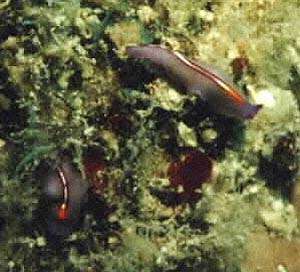
I found these around Saxon Reef, near Cairns, North Queensland. They might be a sort of flatworm because there are no gills visible. Just a wild guess on my part, I'm pretty much an amateur at this.
Thanks again
Michael.
Michael Dyck
Shady Cove
Oregin, USA
famdyck@medford.net
Dyck, M., 1998 (May 27) Marine Flatworms?. [Message in] Sea Slug Forum. Australian Museum, Sydney. Available from http://www.seaslugforum.net/find/60Yes they are flatworms, which are often mistaken for nudibranchs. Flatworms usually glide along much faster than nudibranchs, are much thinner and tend to break up if you handle them. It is true that they don't have gills, but dorids often have theirs contracted. In the field even the most experienced collector occasionally collects a flatworm by mistake or if they are not quite sure. The photo above of Paraplanocera oligoglena (A) shows most of its organs through the almost transparent body wall. The white branched central structure is the proboscis. When feeding, the proboscis is everted through the mouth which is in the centre of the underside of the body. The pale whitish network extending through most of the body is the multi-branched gut which gives these worms the name 'polyclad' (= many branches). Polyclads are hermaphrodite, that is they function as both males and females, and all the other organs that can be seen through the transparent body wall are part of the male and female reproductive systems. Many marine flatworms are very colourful. Wolfgang Seifarth has an excellent website for flatworms .... Bill Rudman
NOTE: The URL of the Marine Flatworms of the World! has changed to:
http://www.rzuser.uni-heidelberg.de/~bu6/index.html [Jan 2000]
